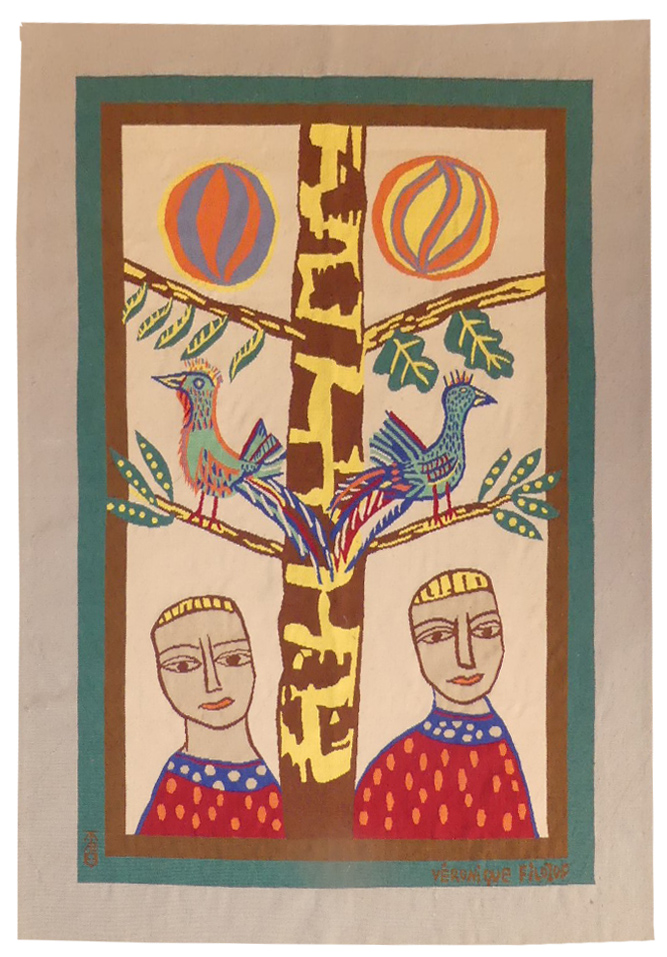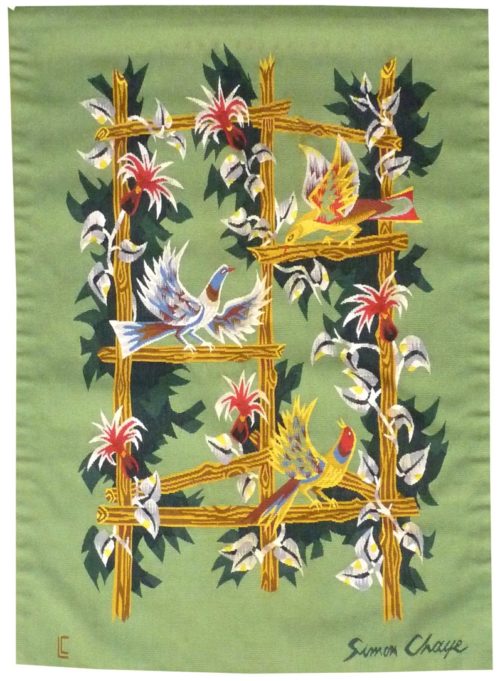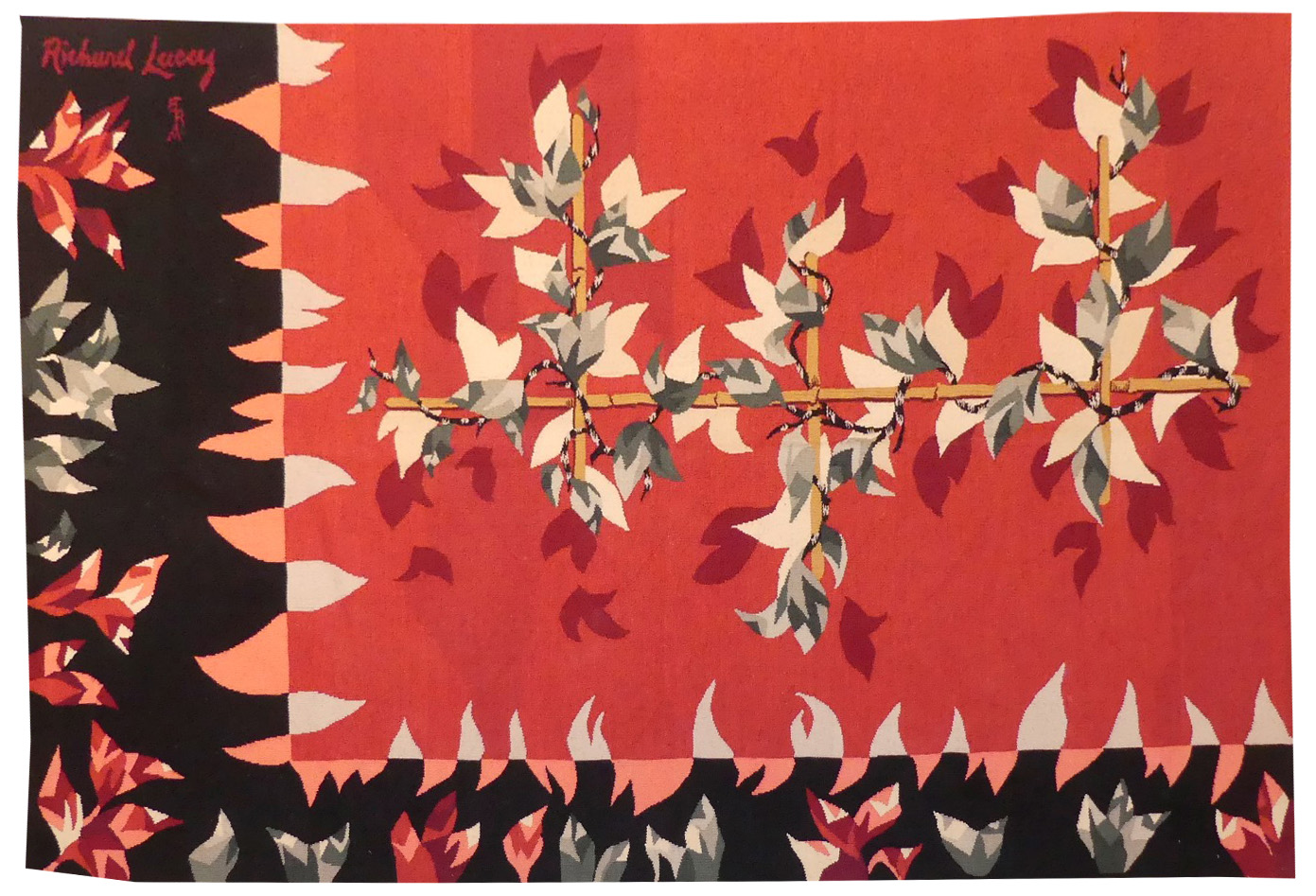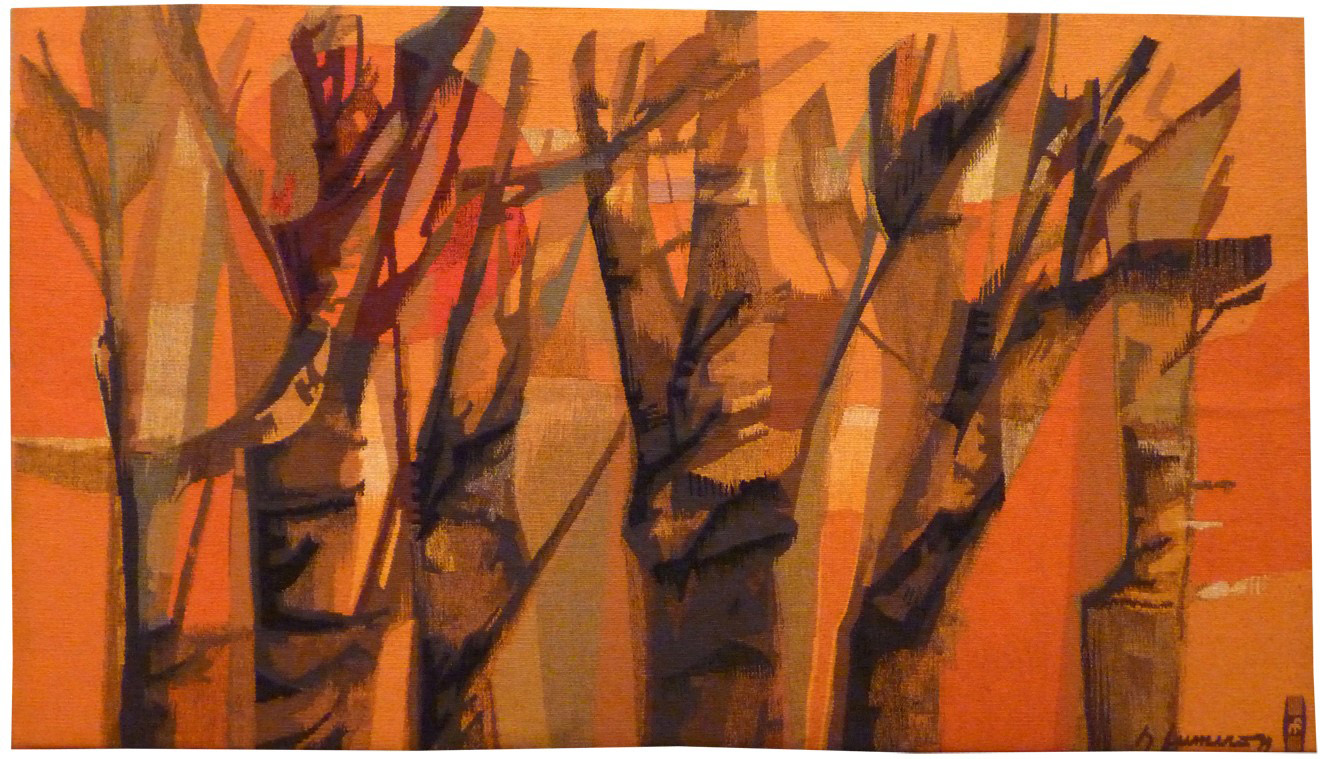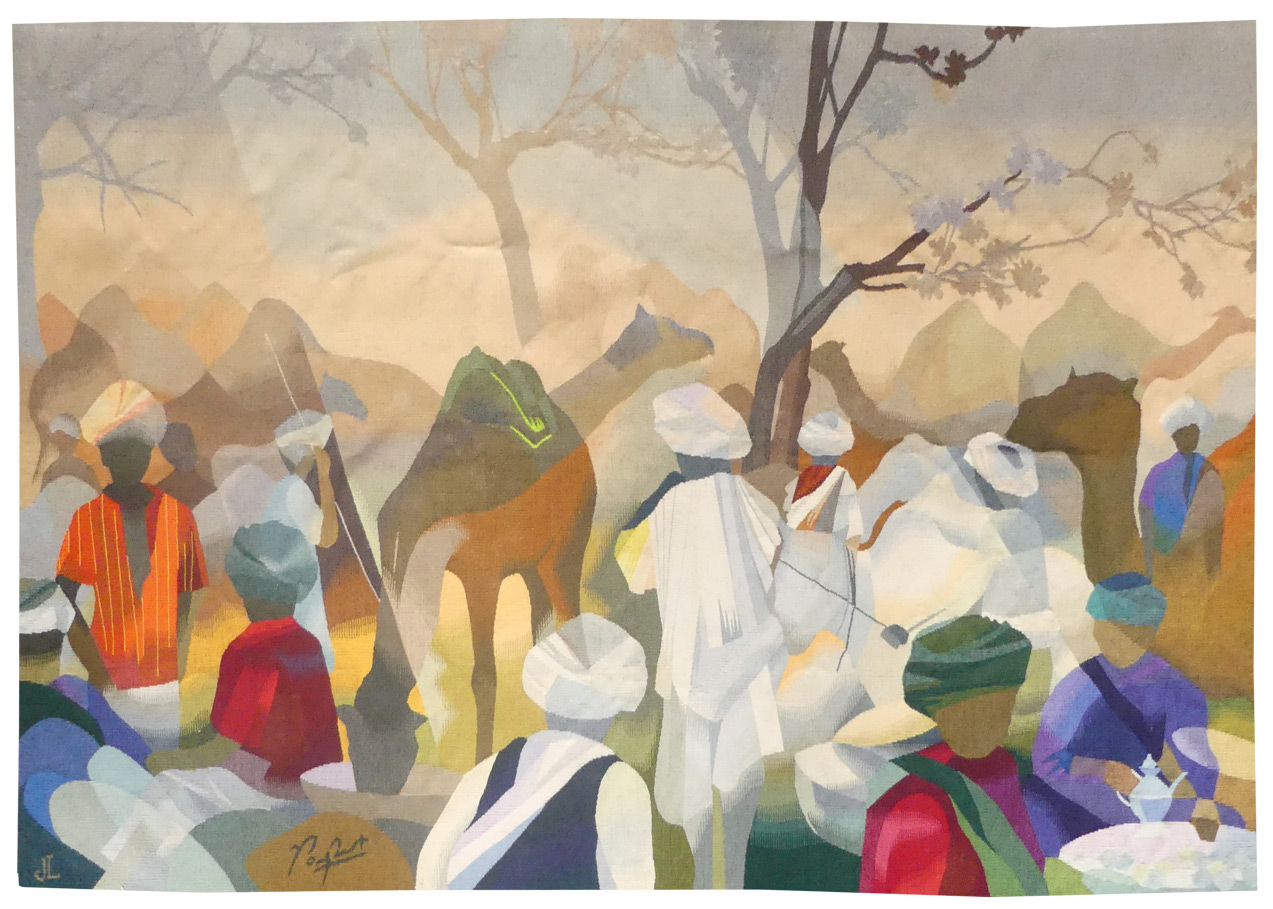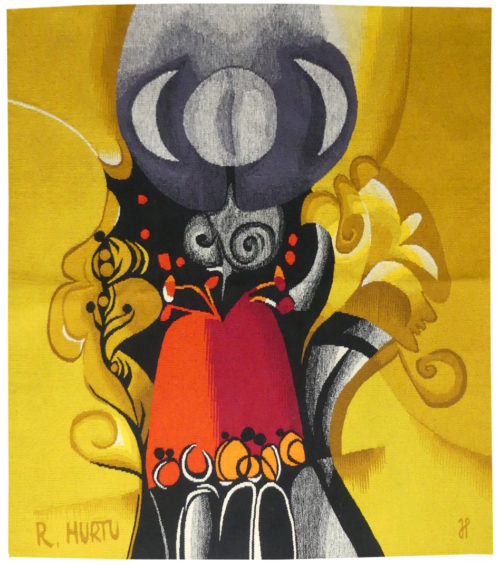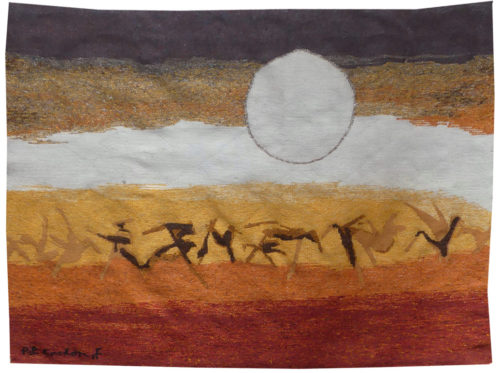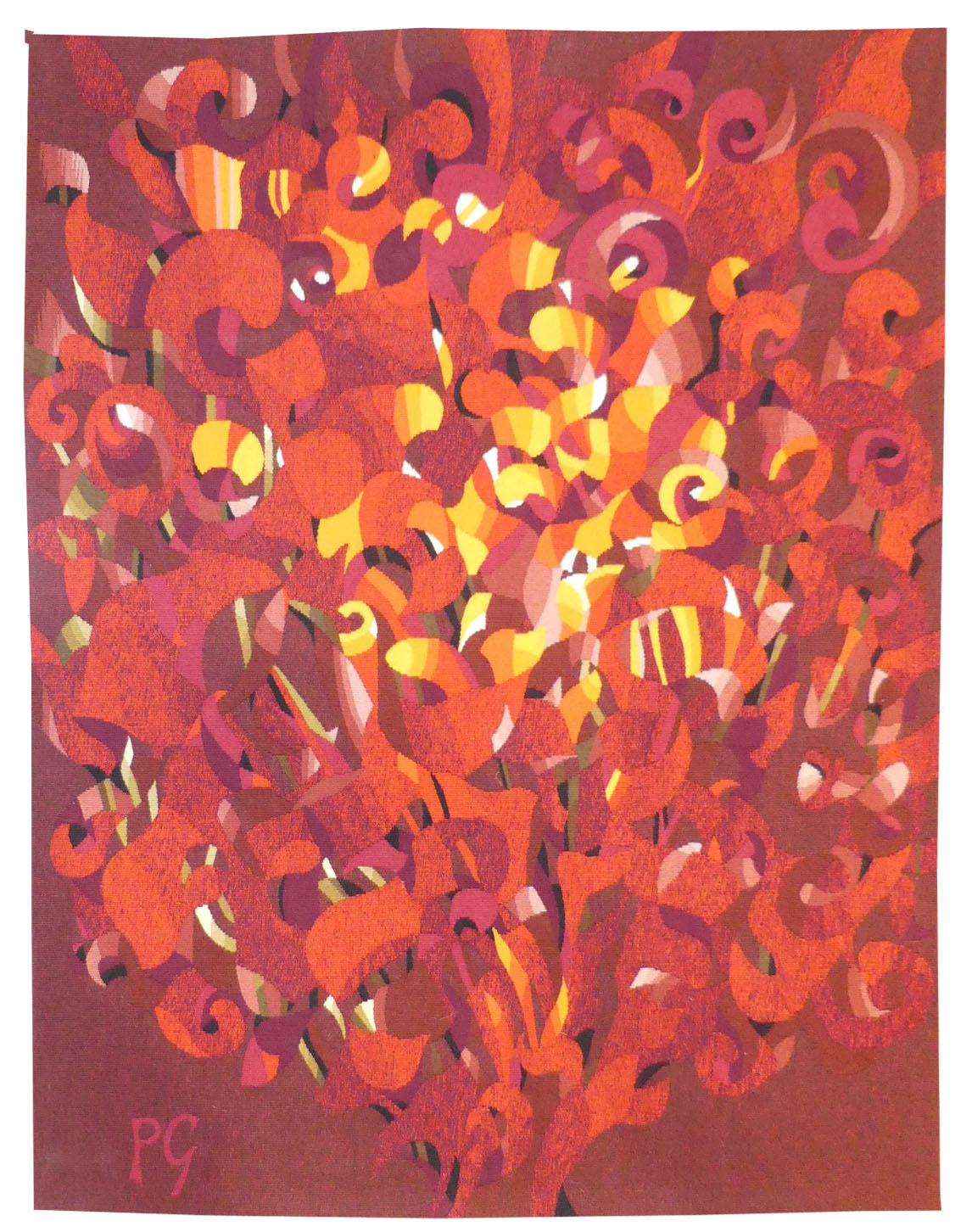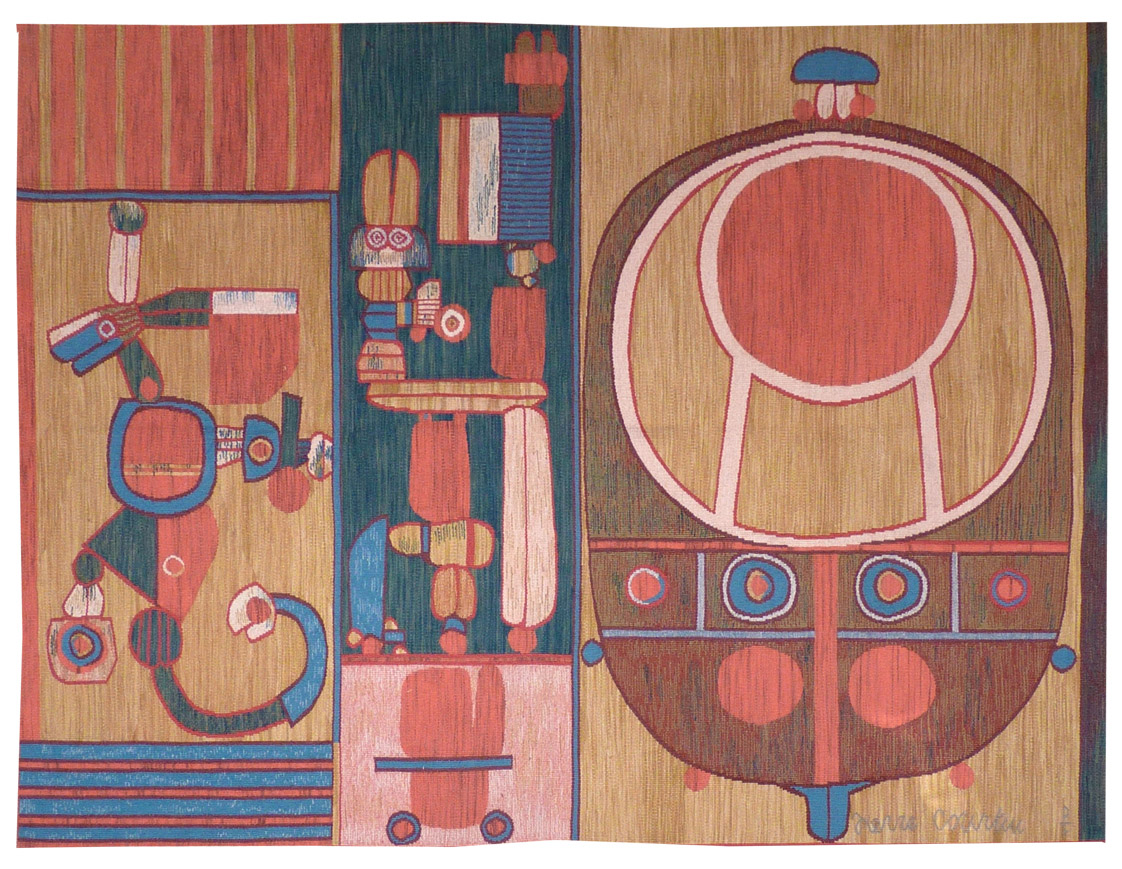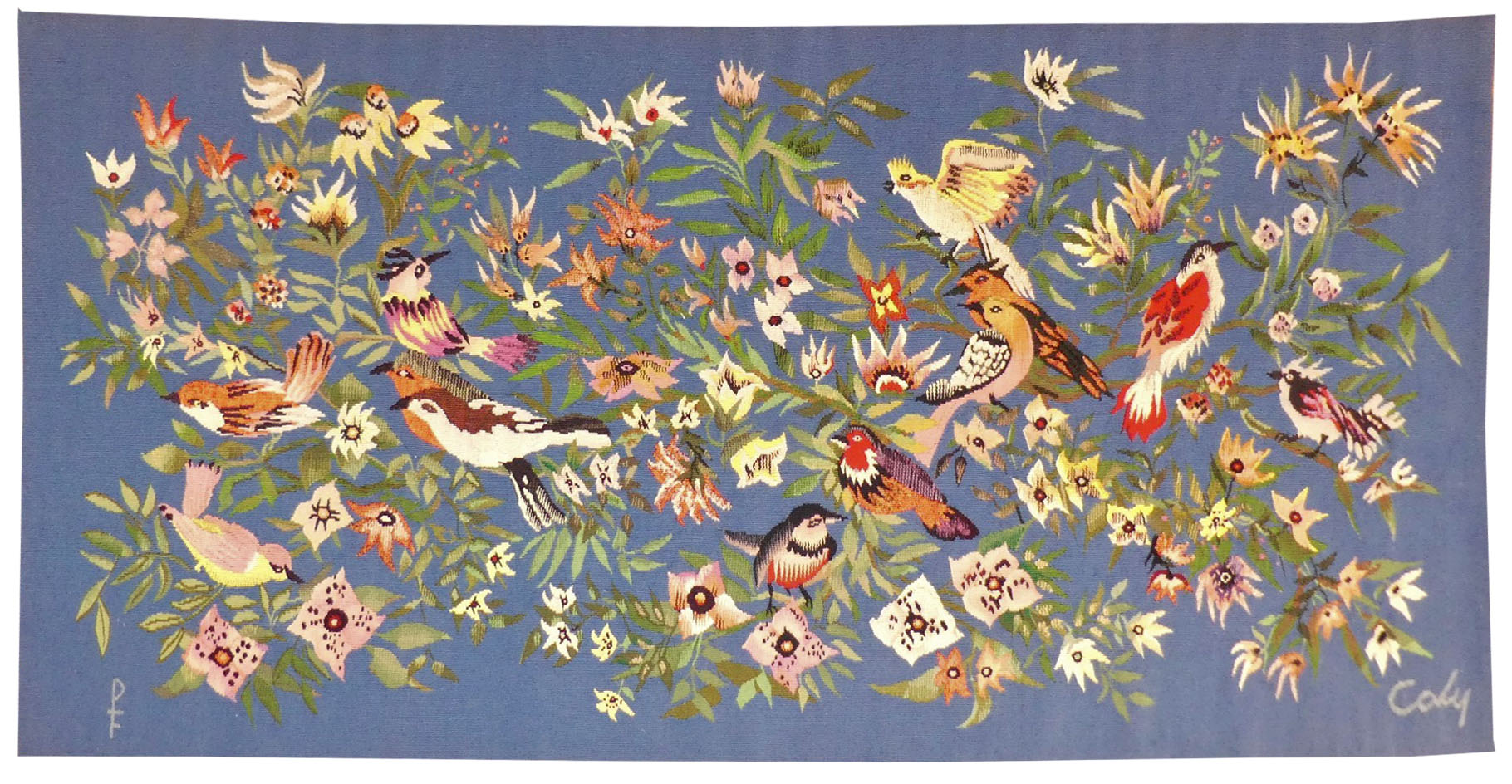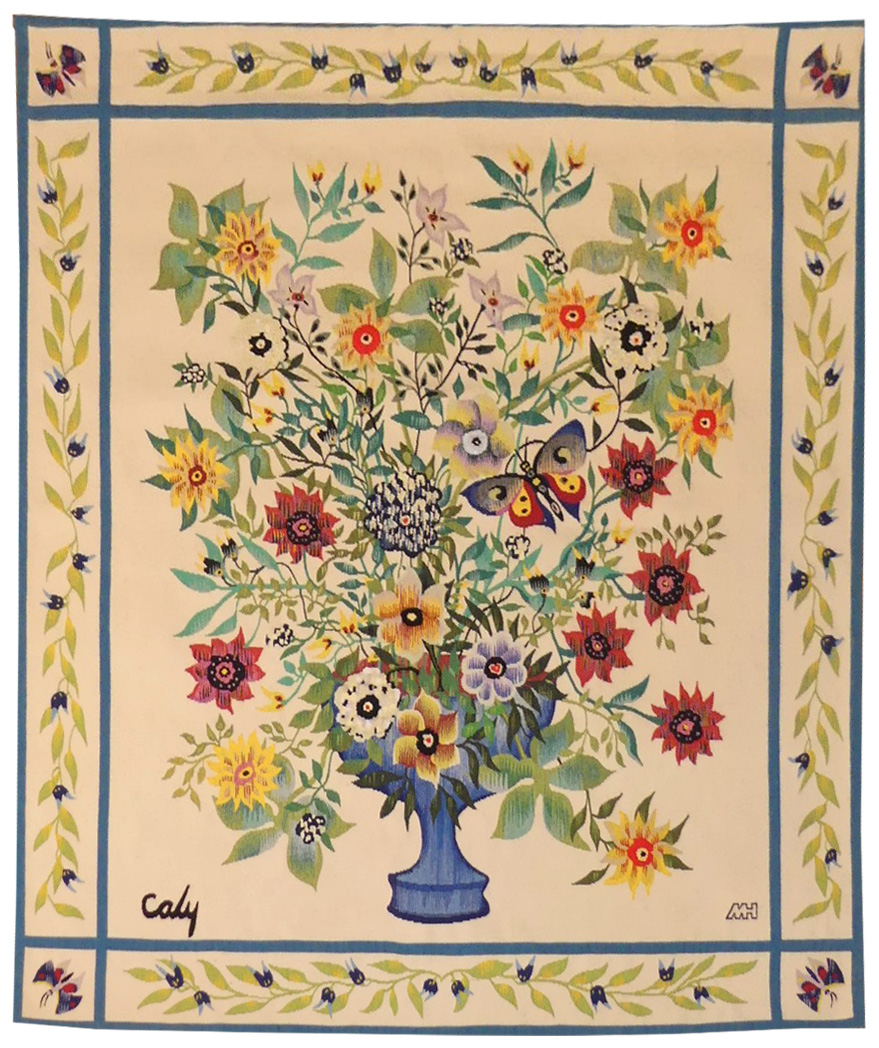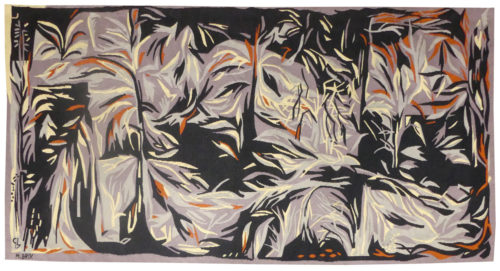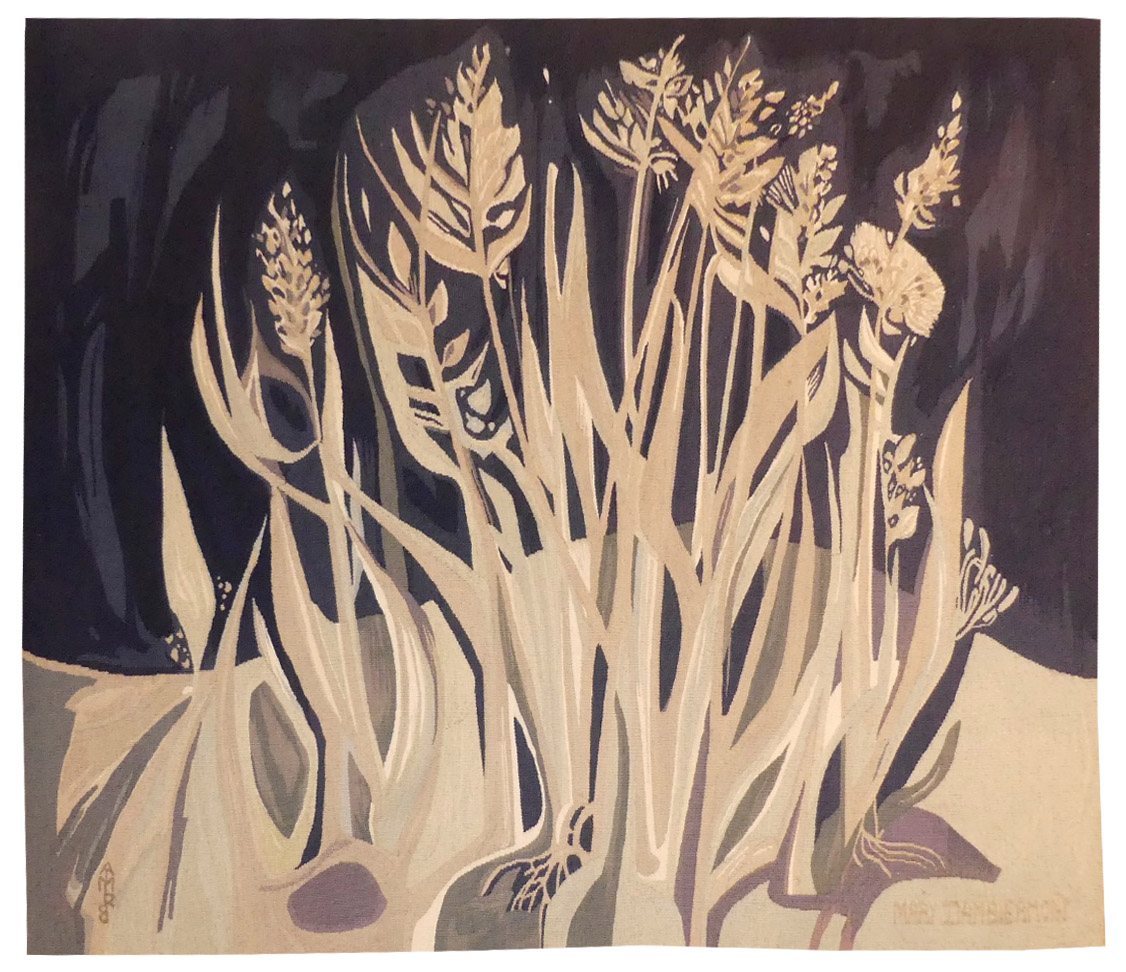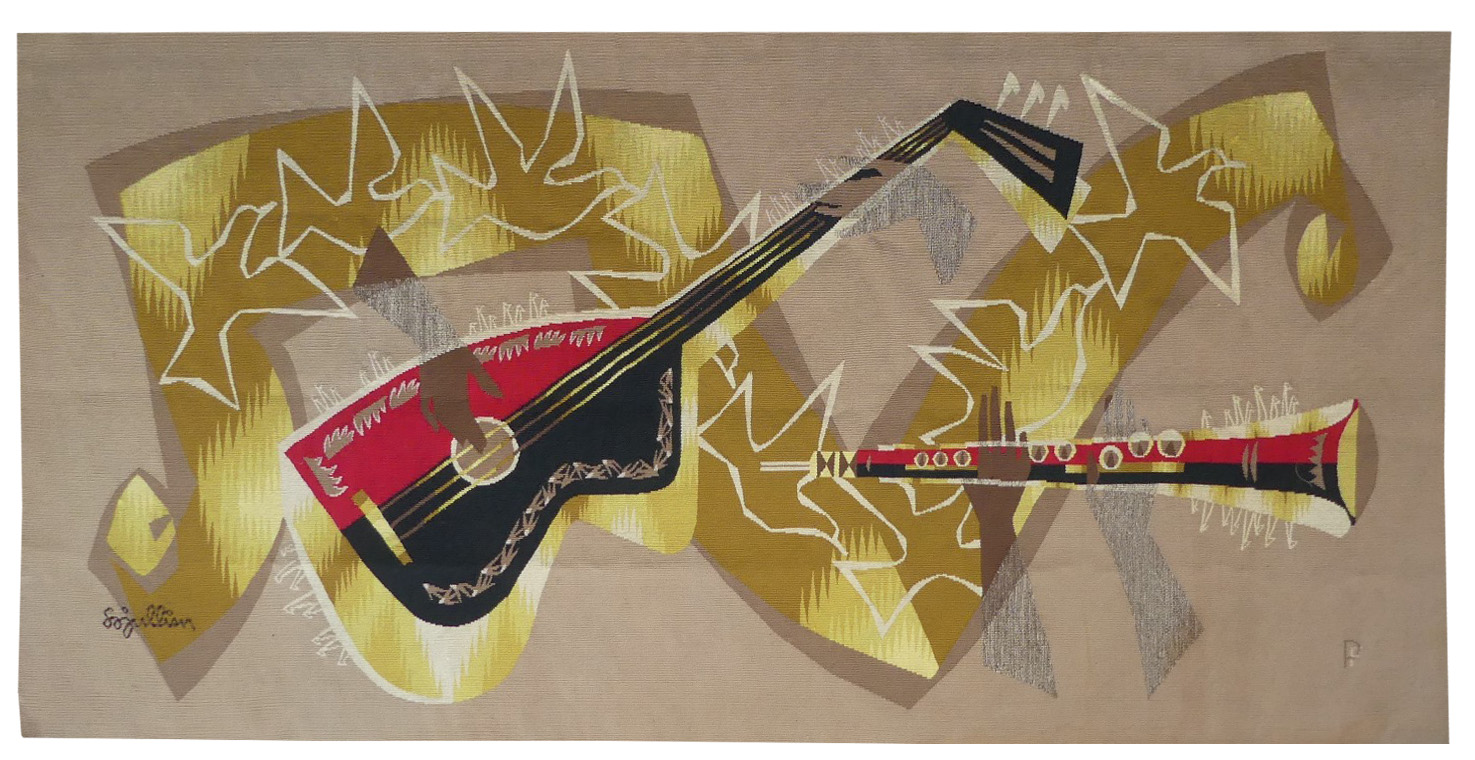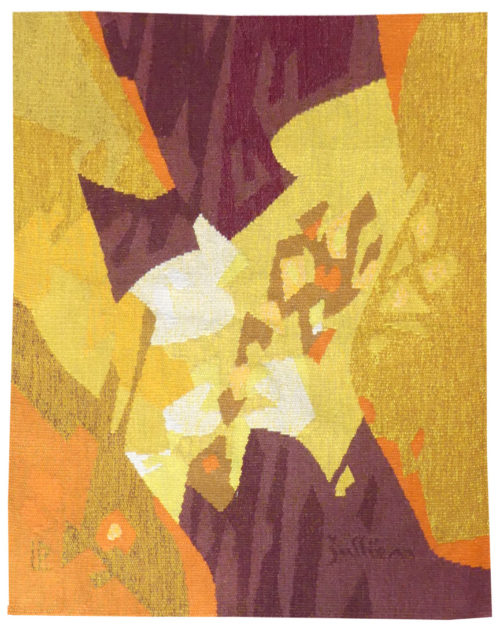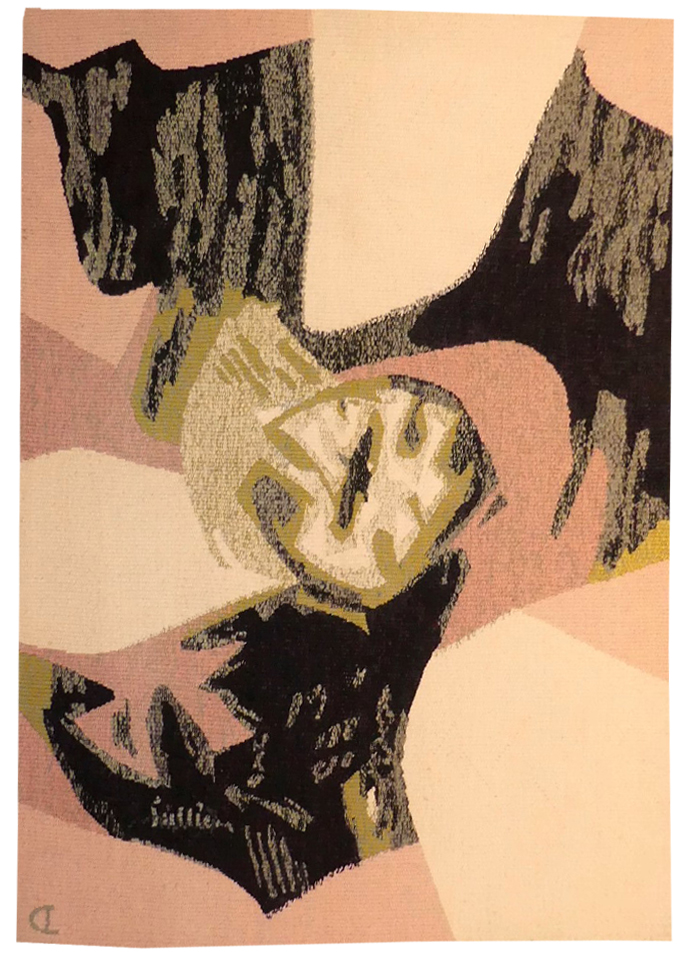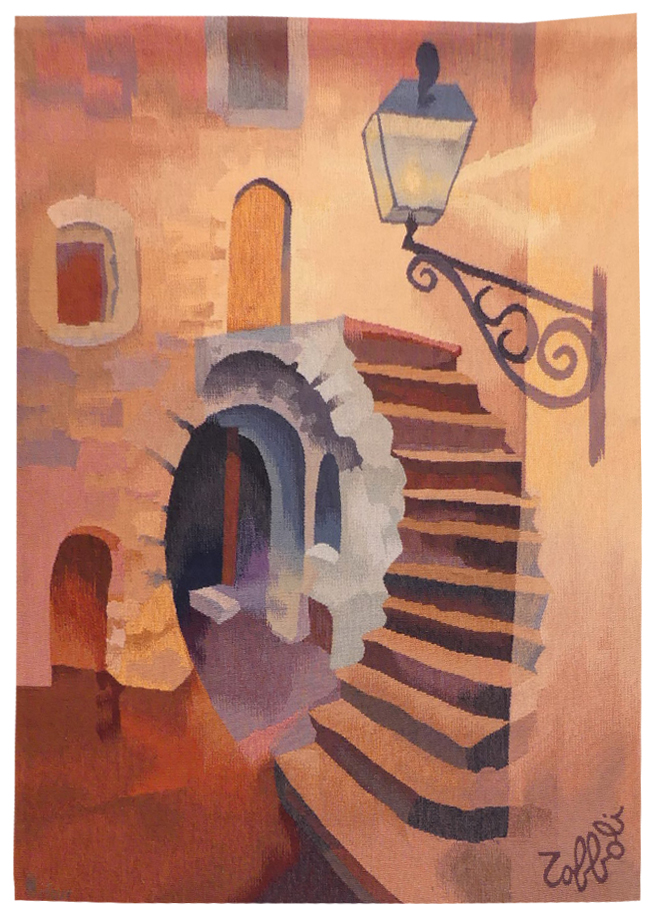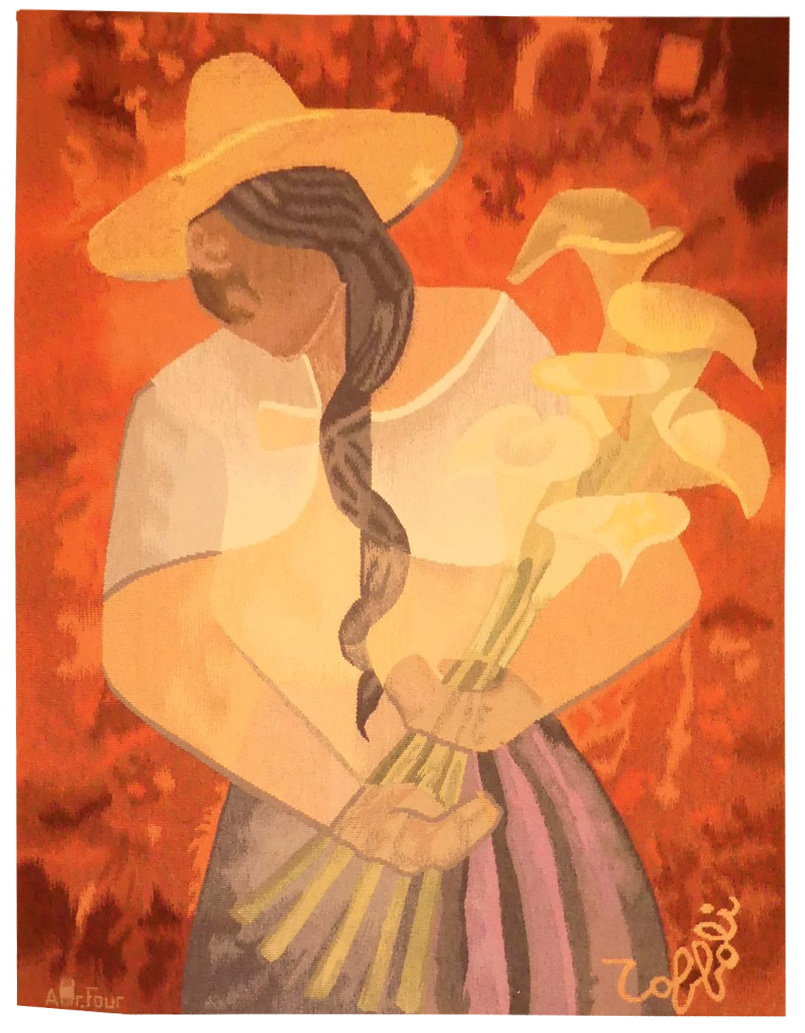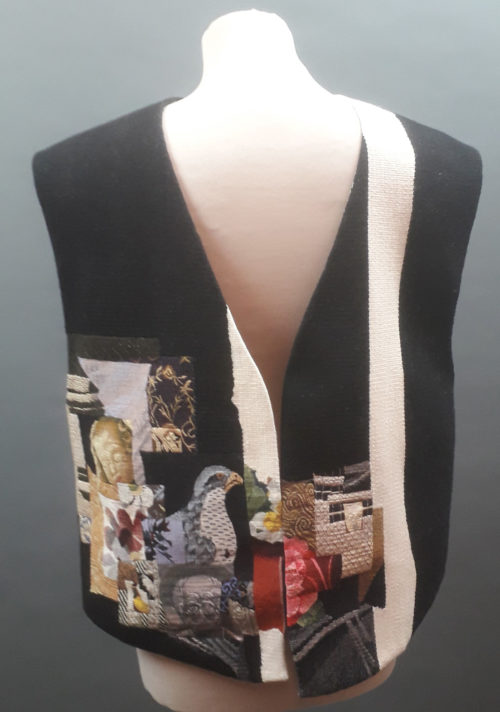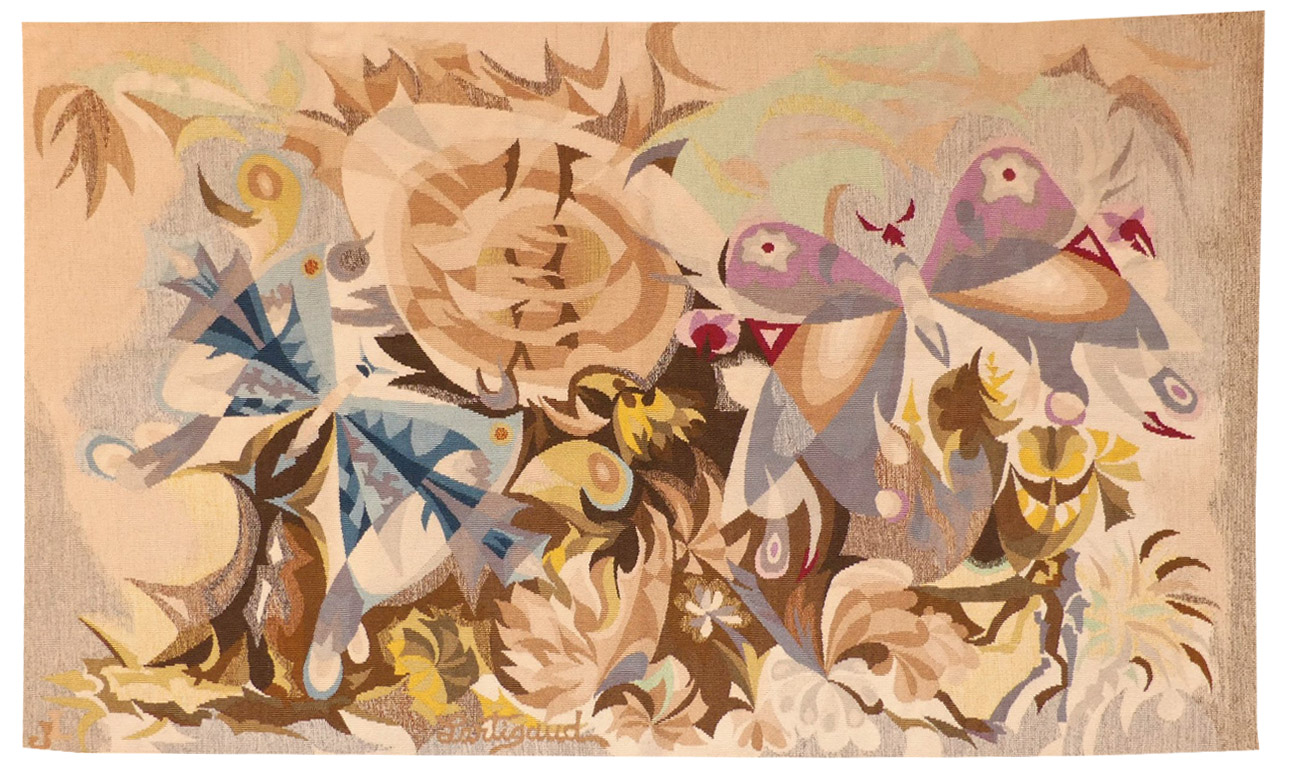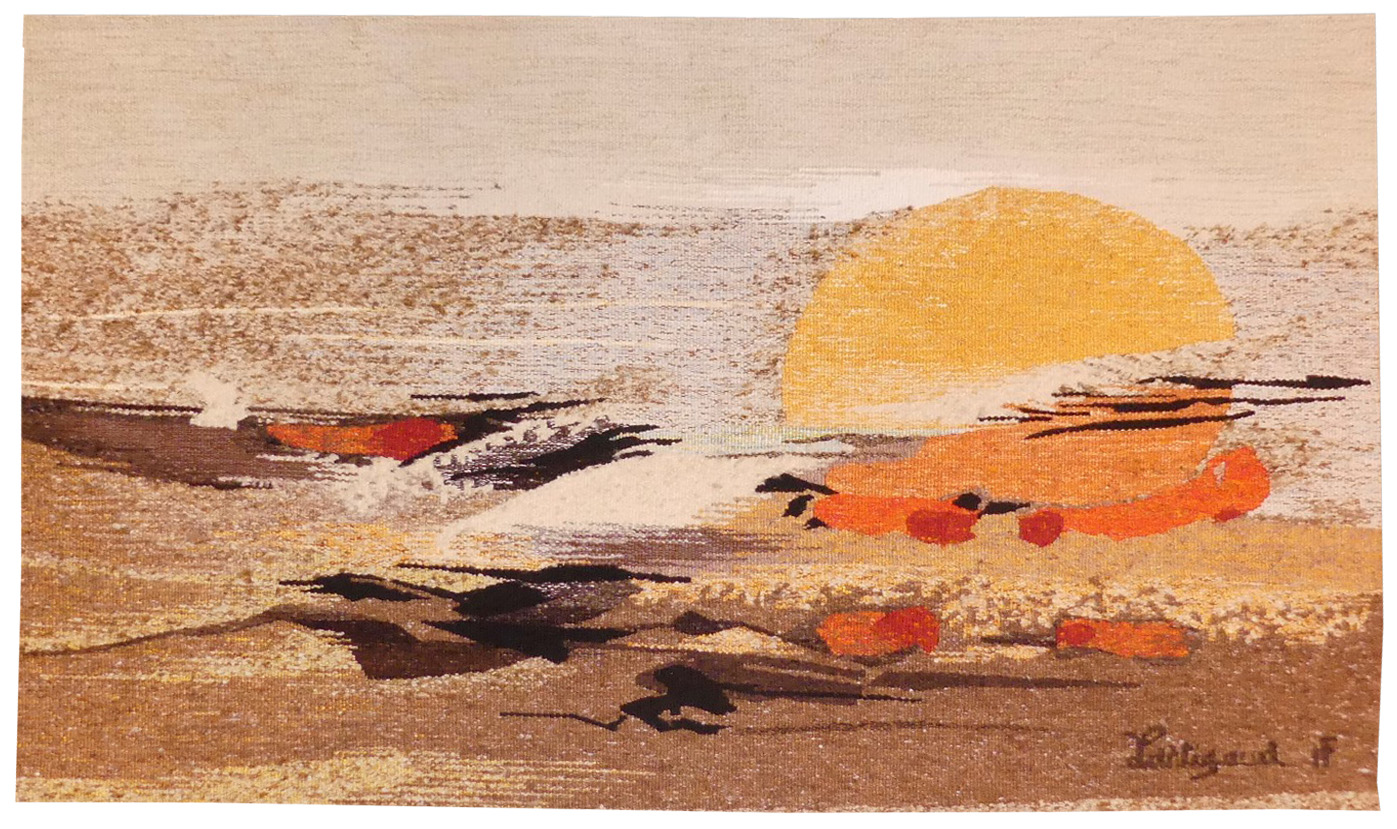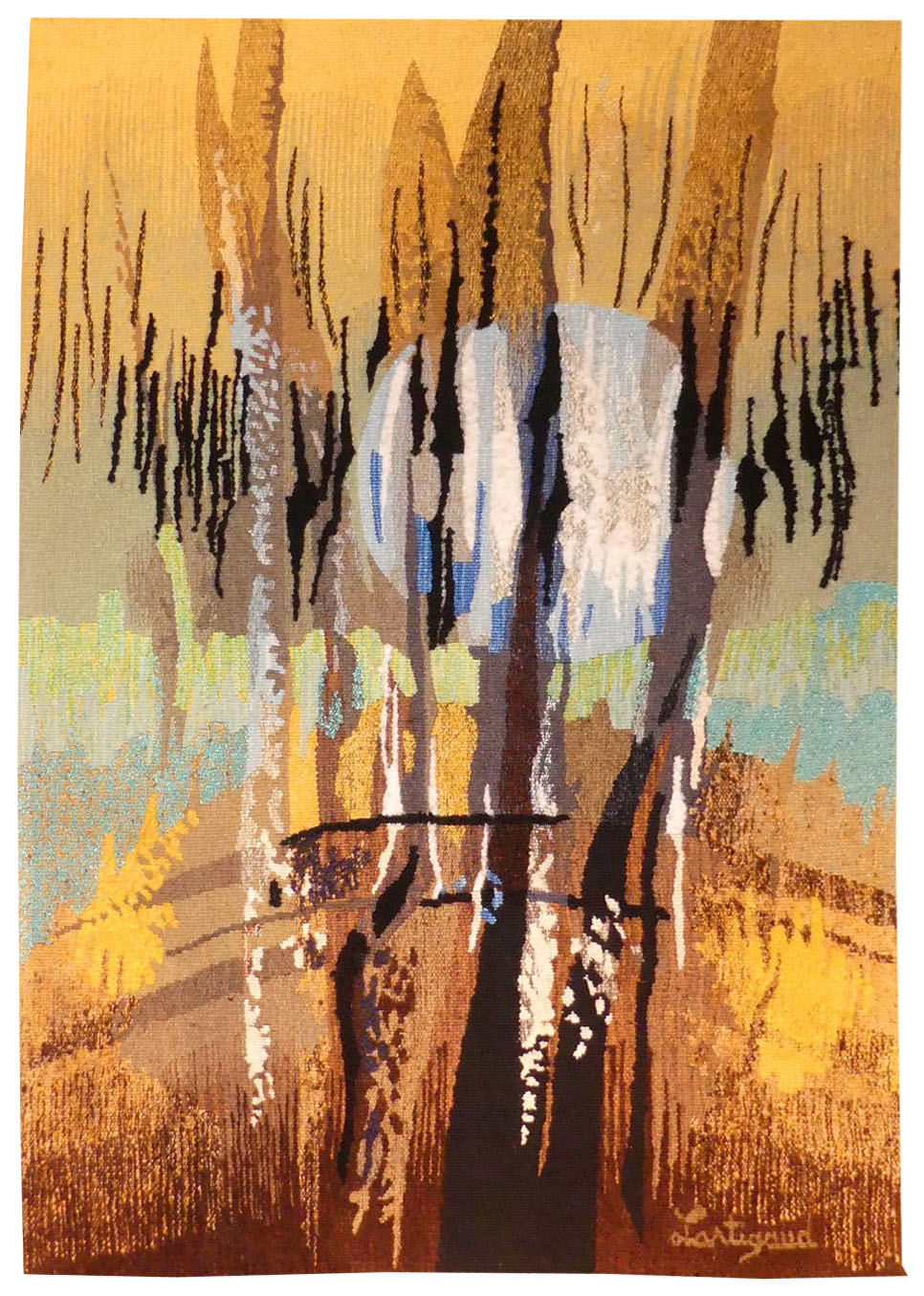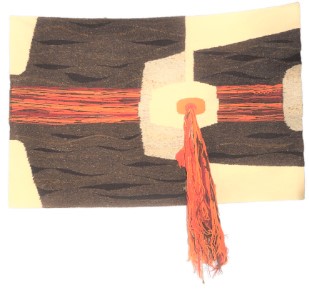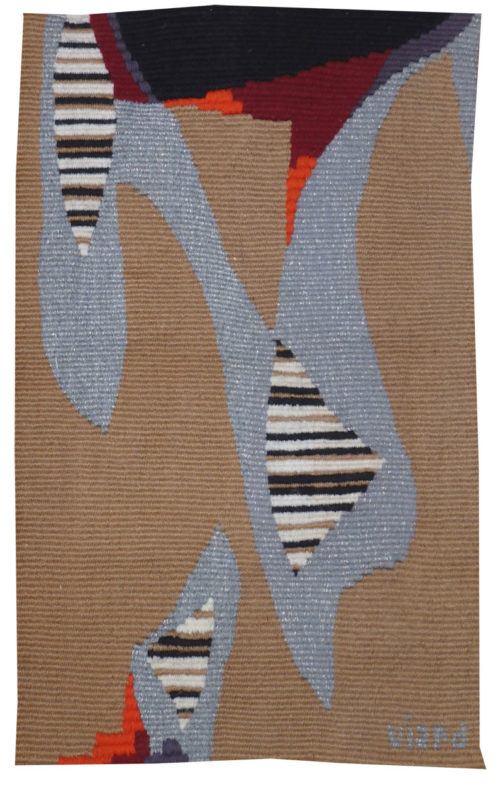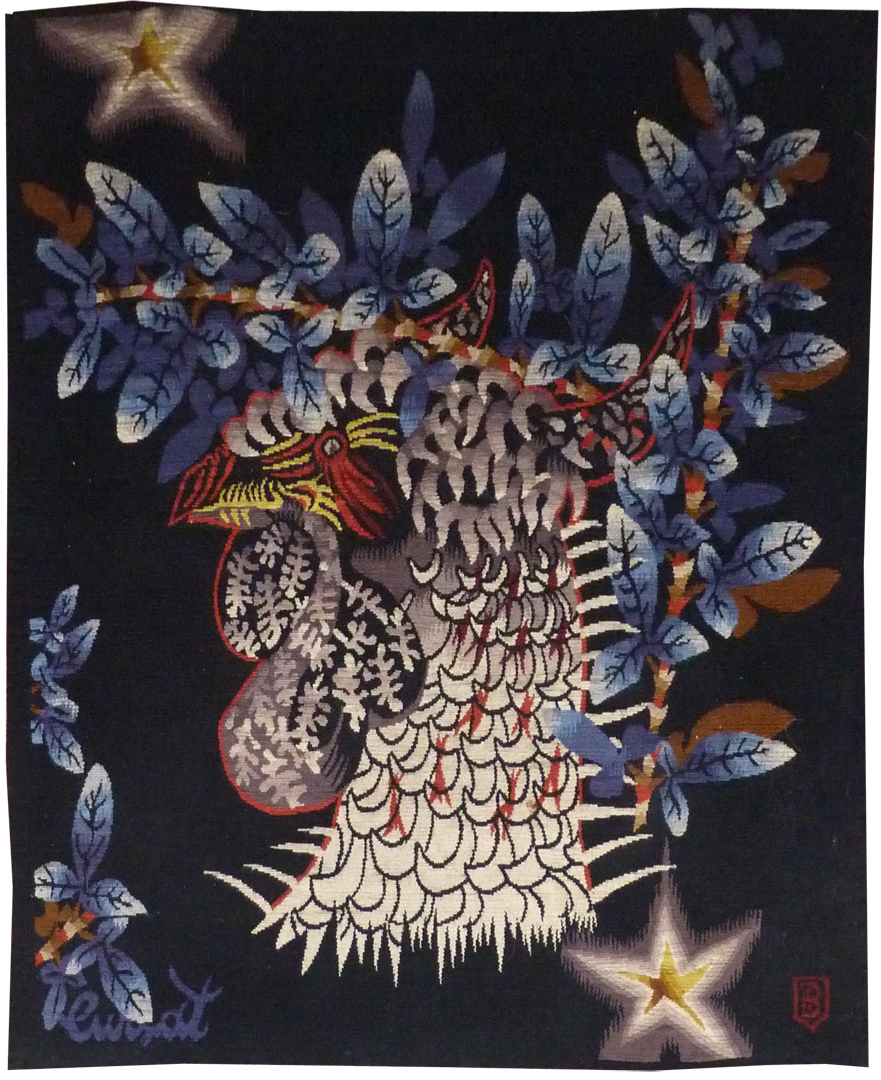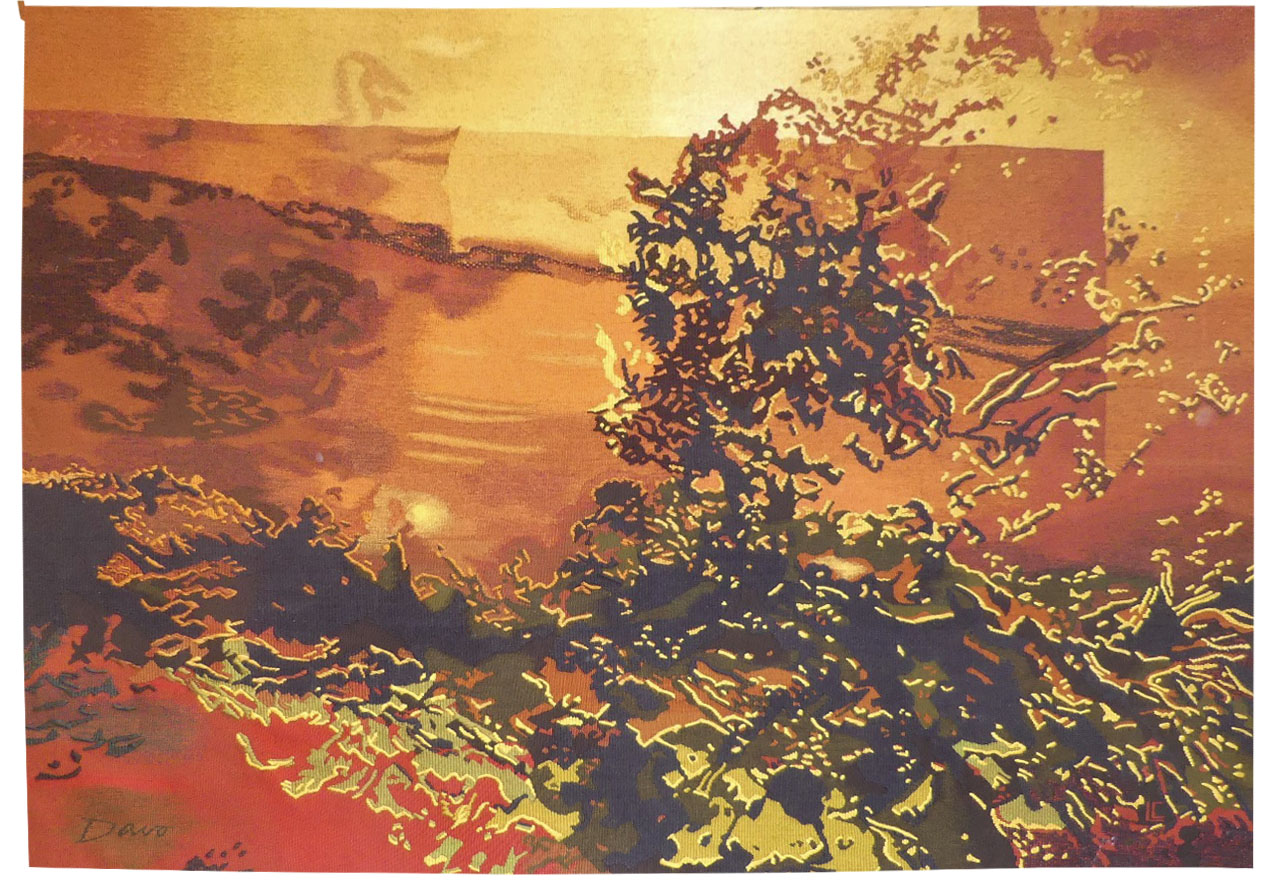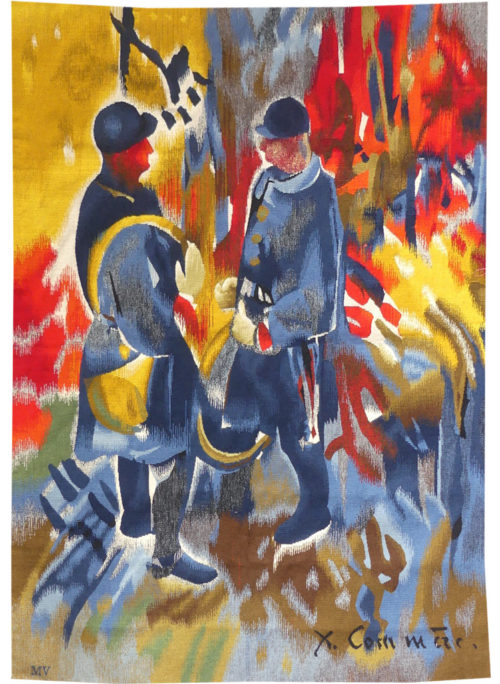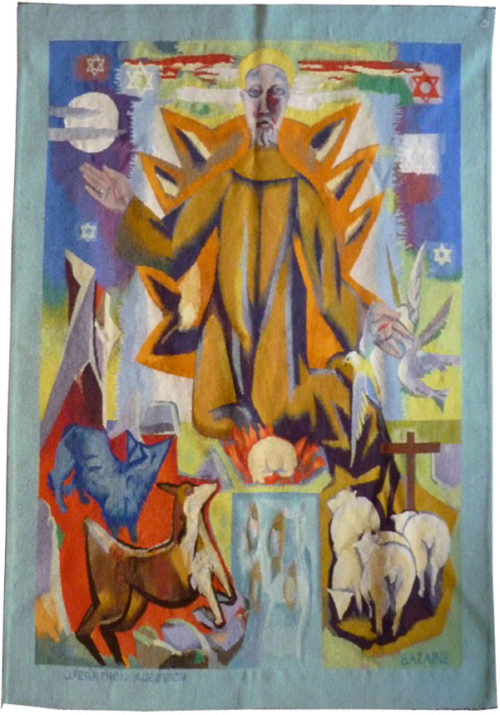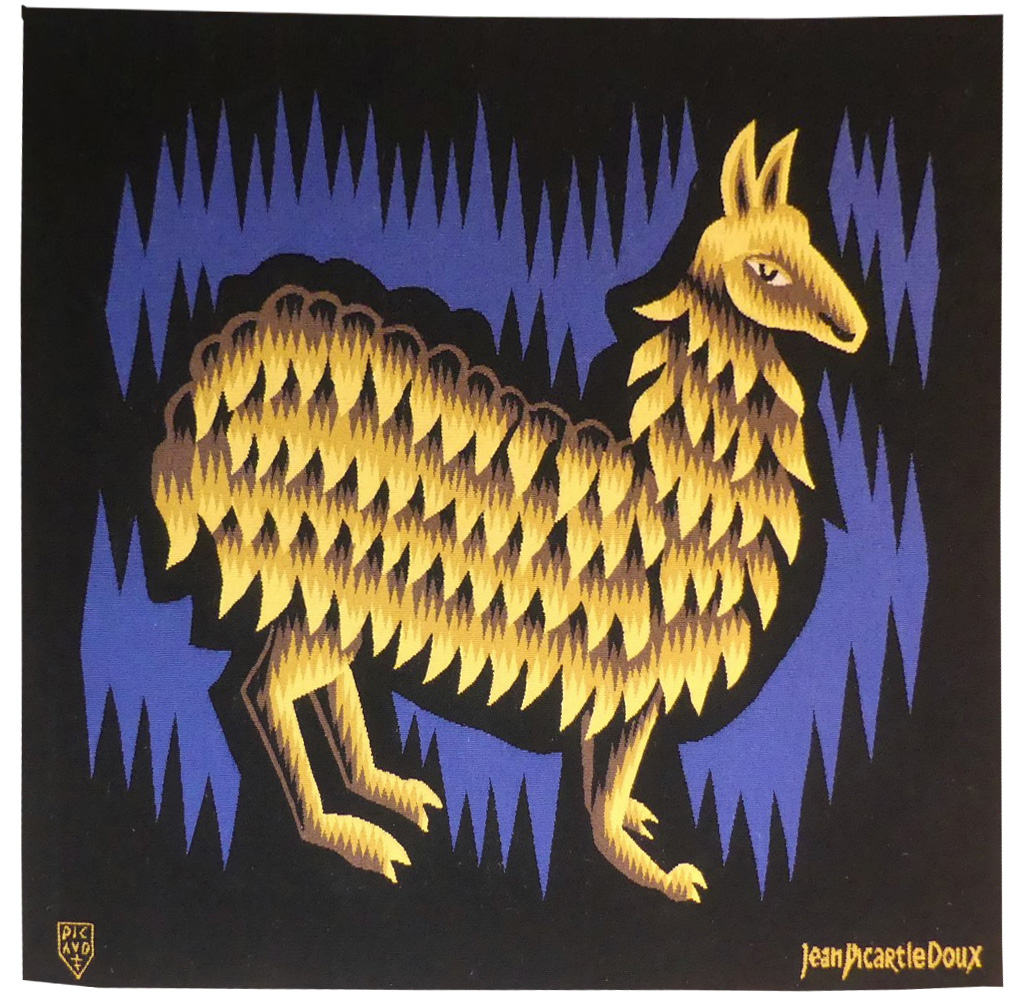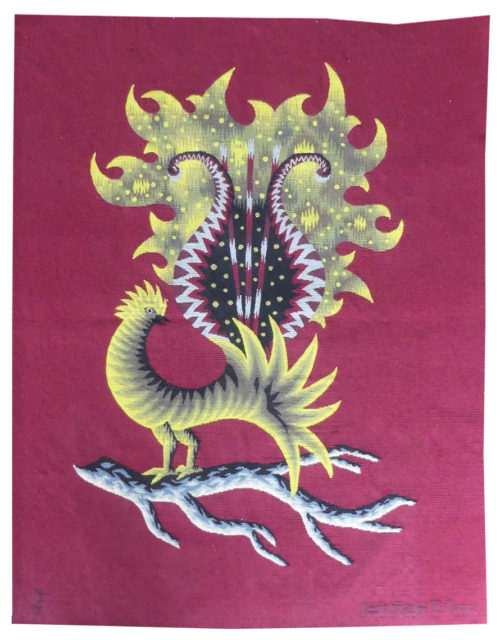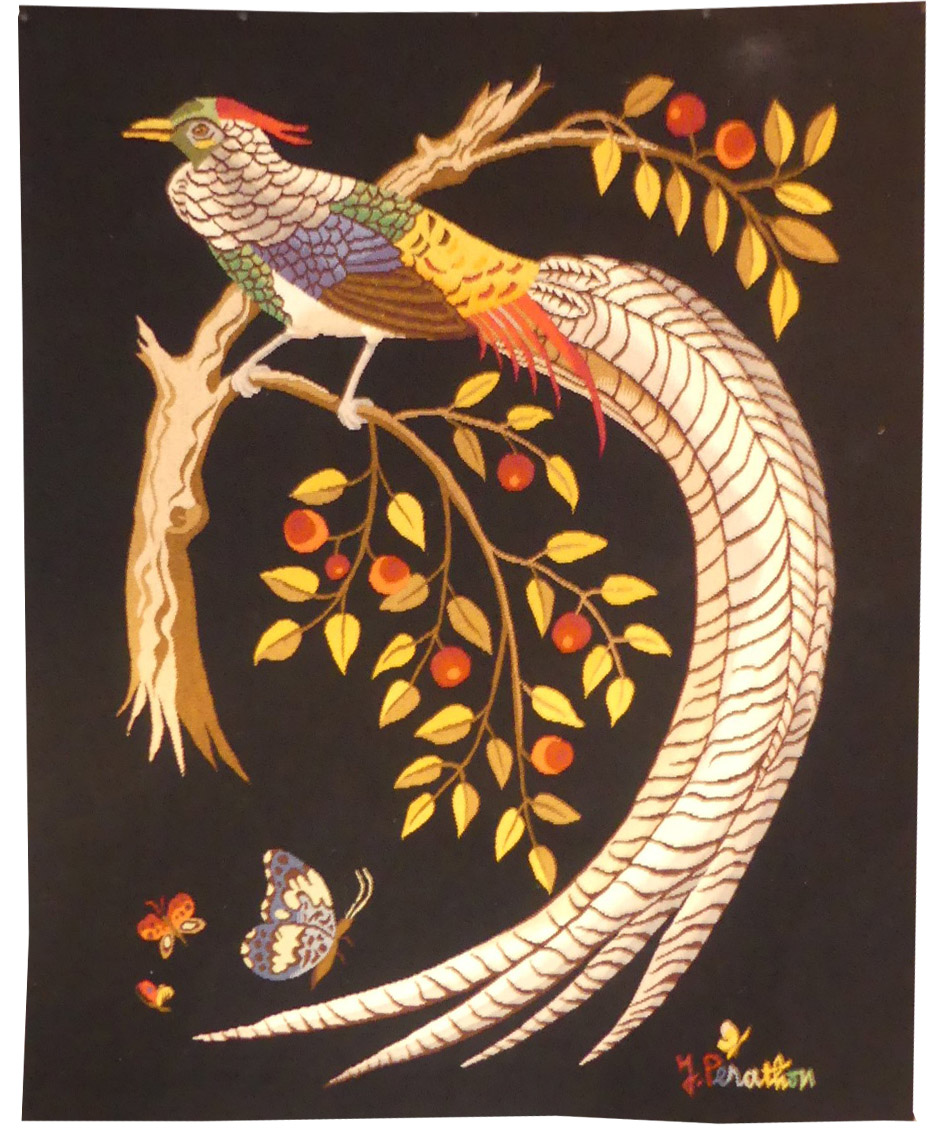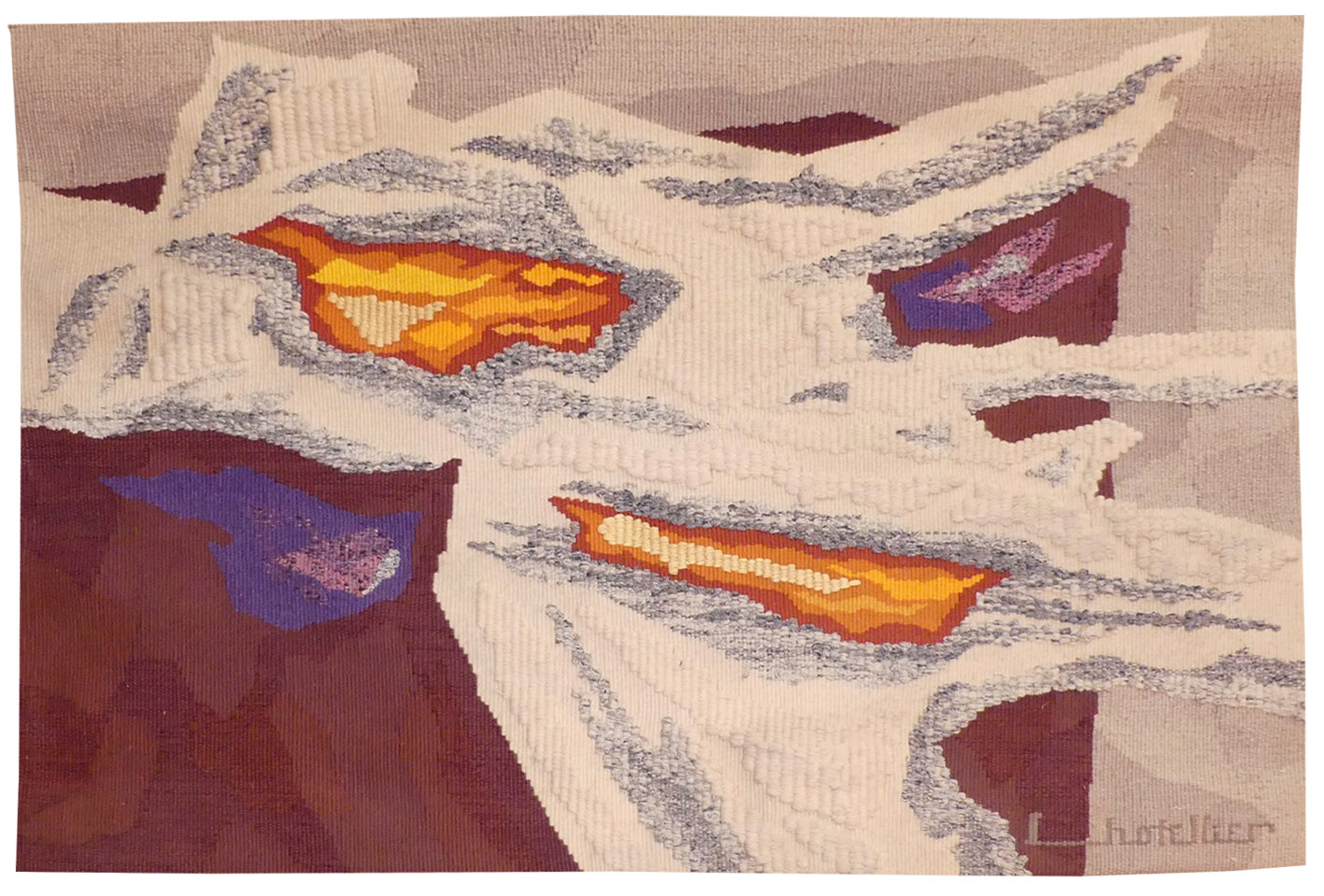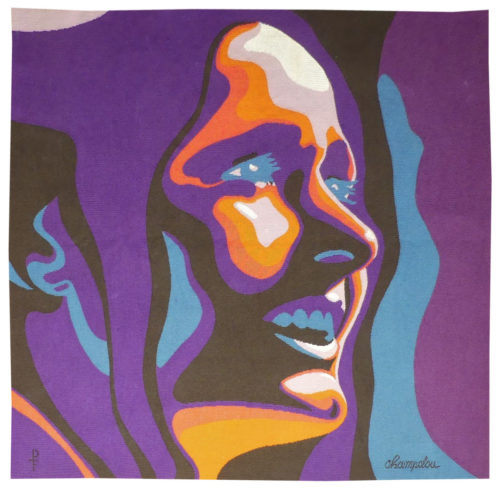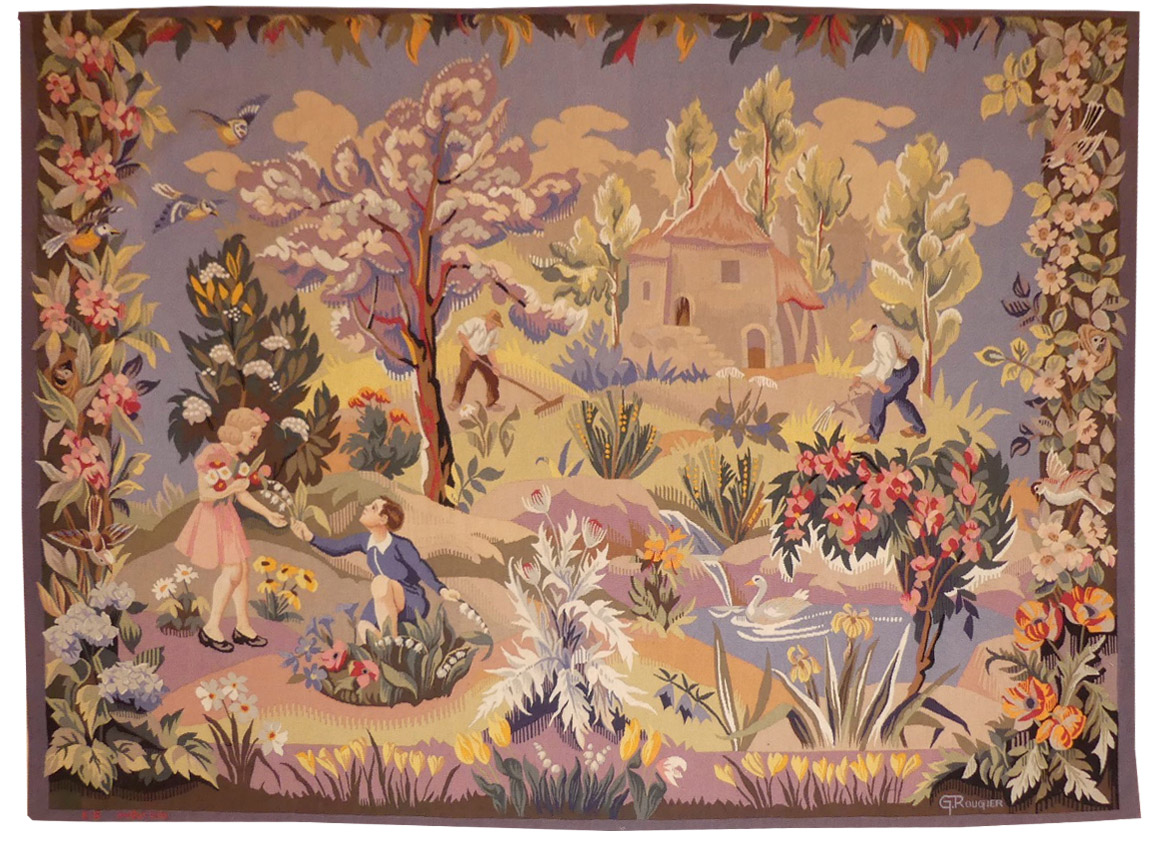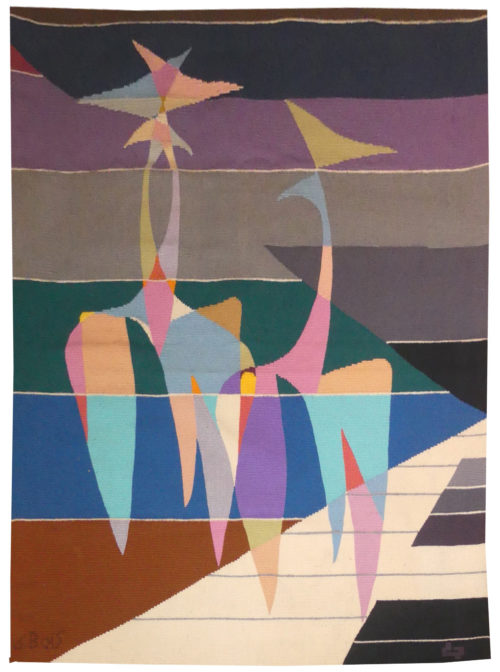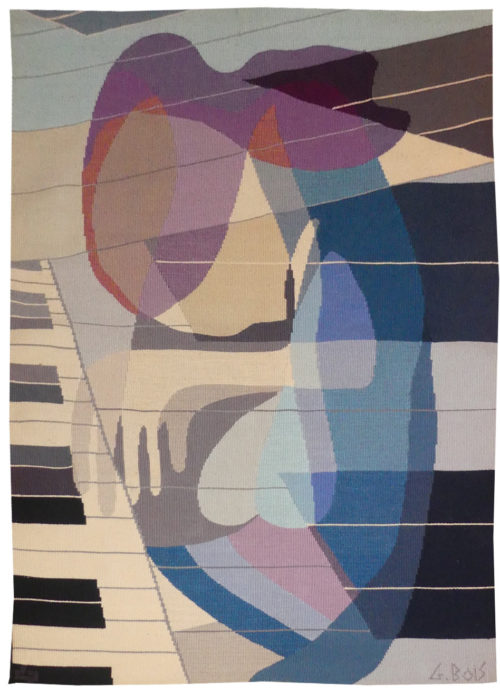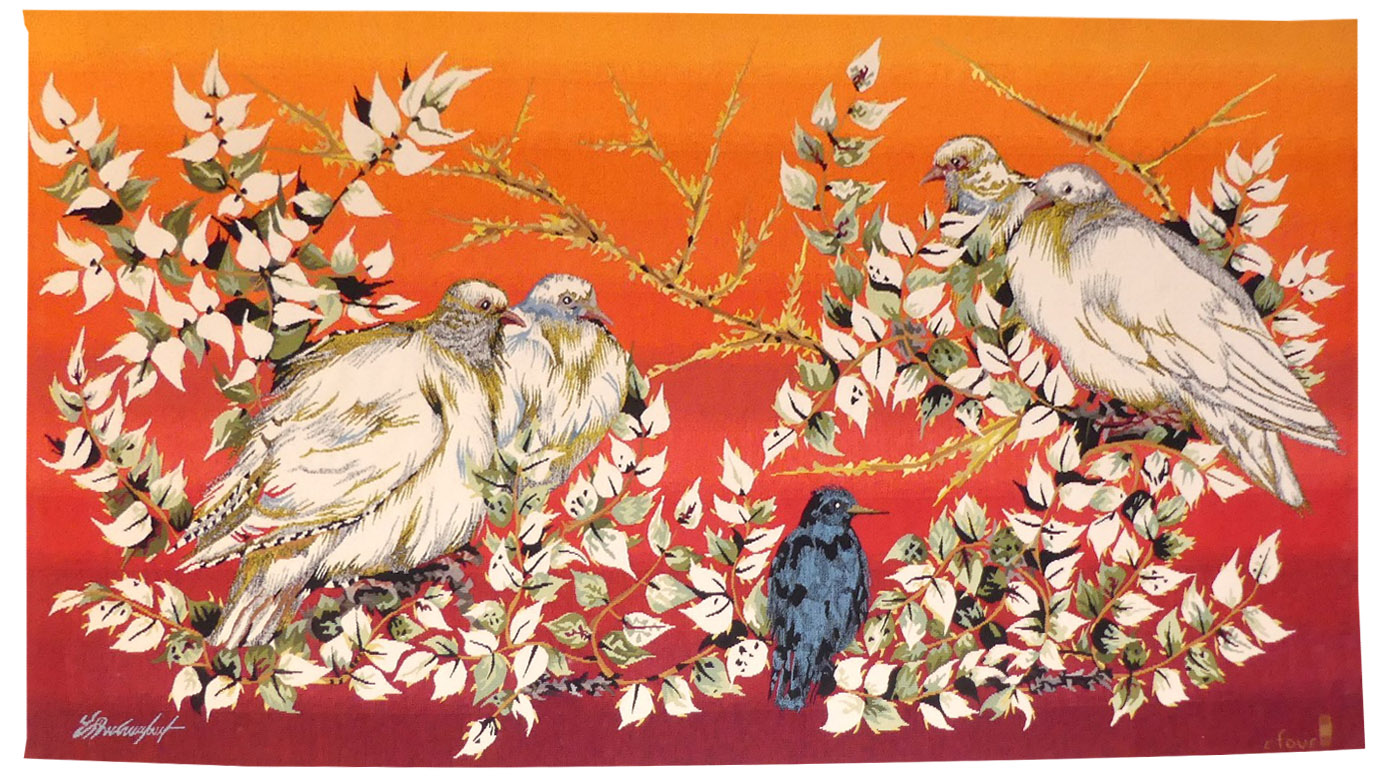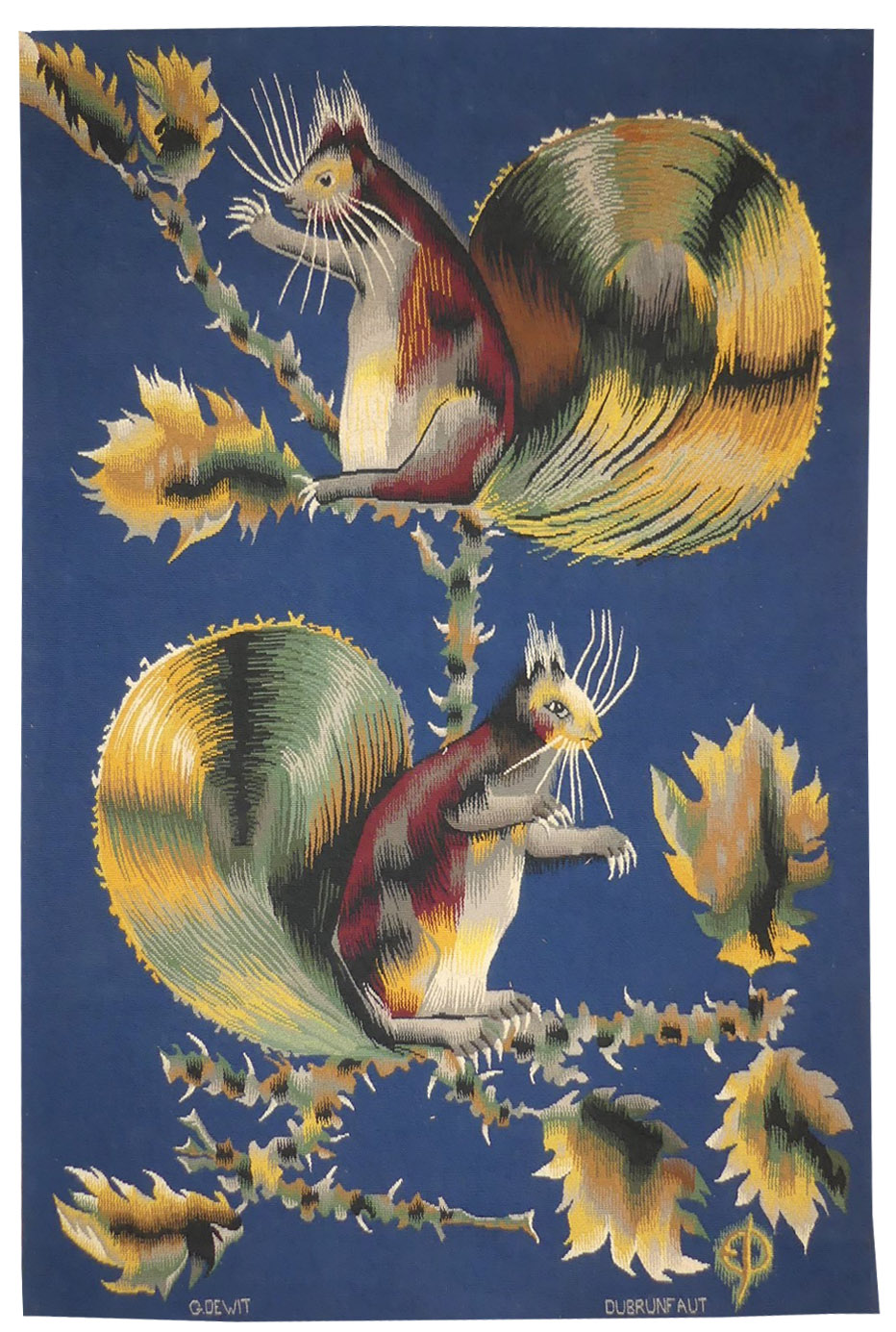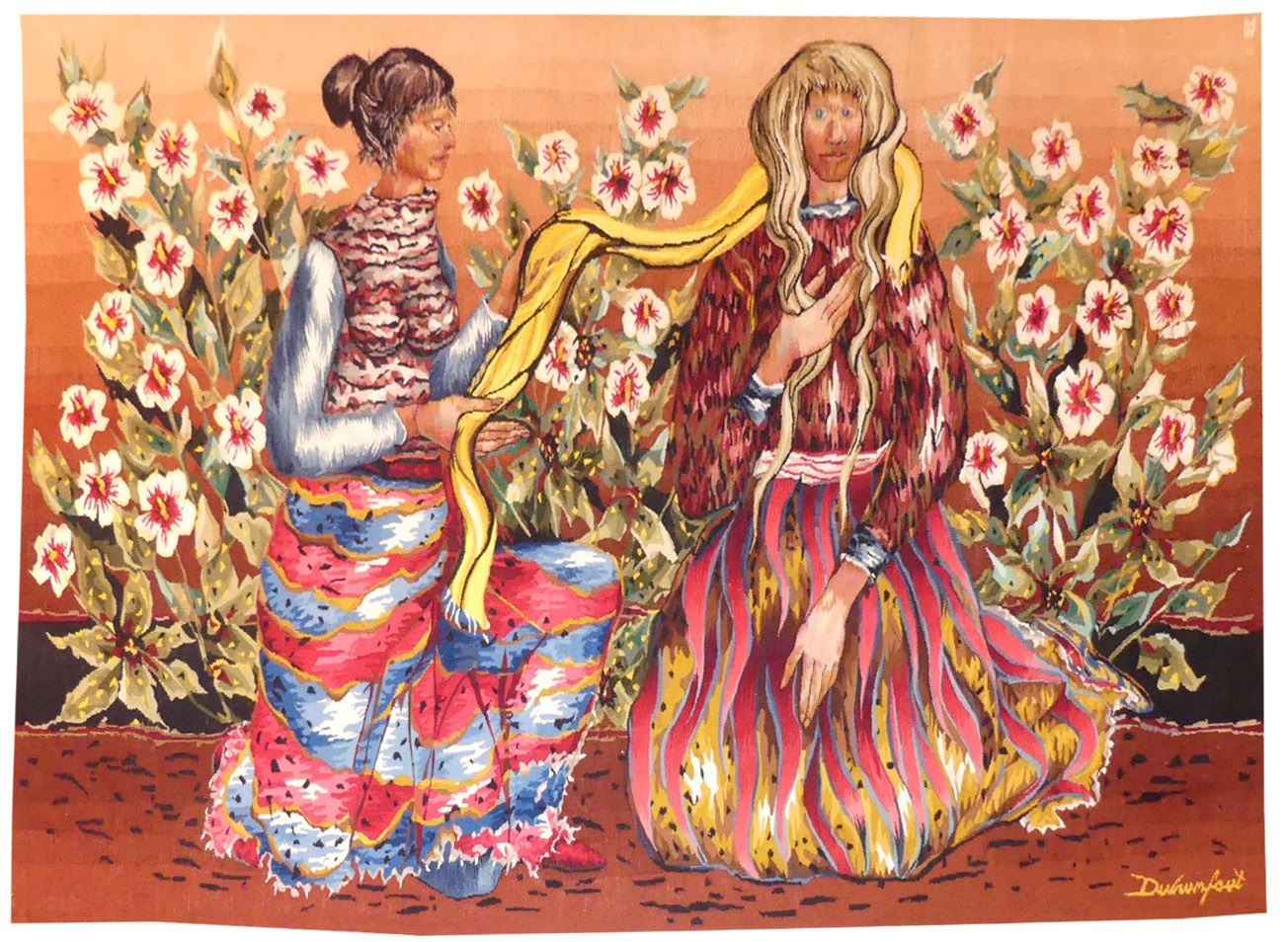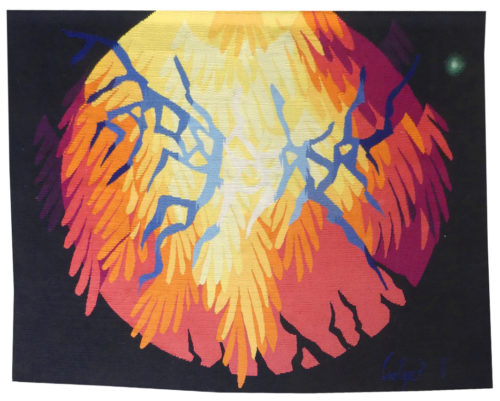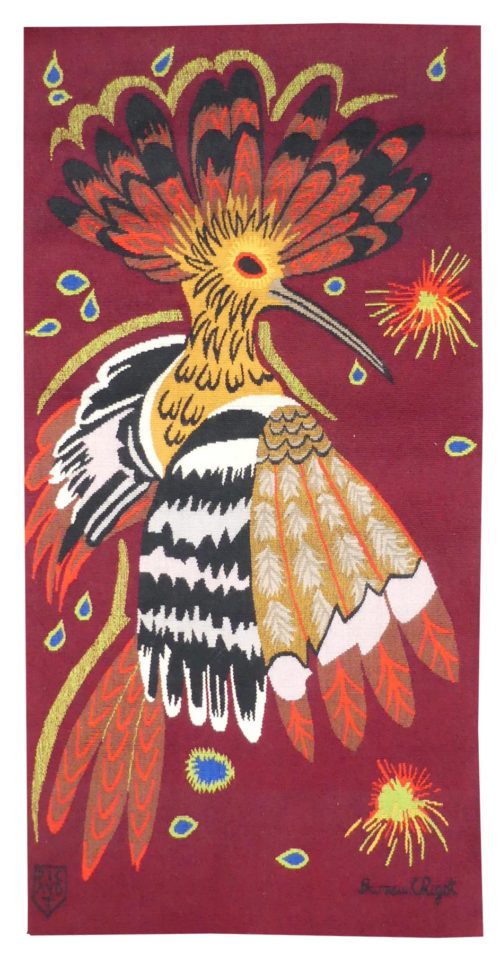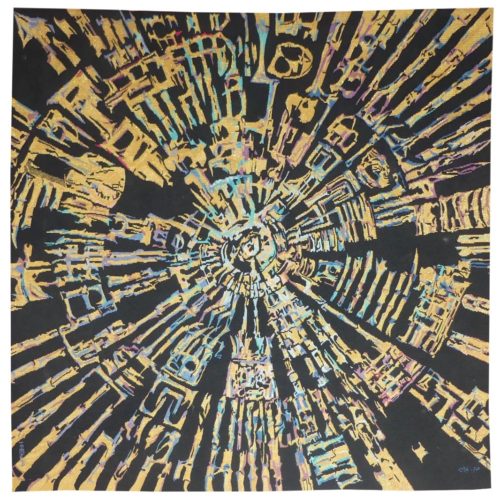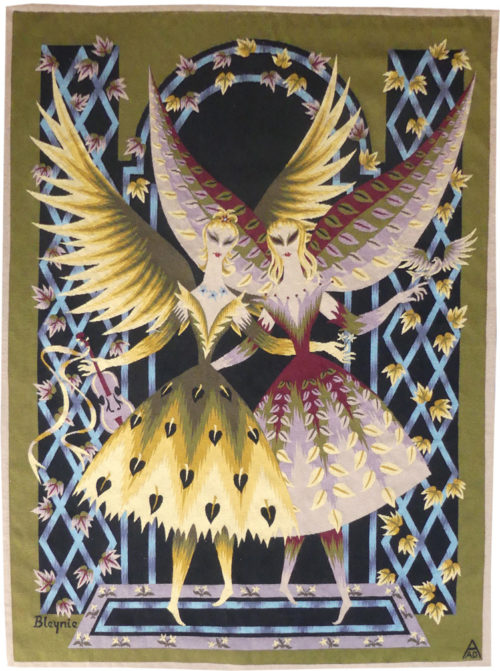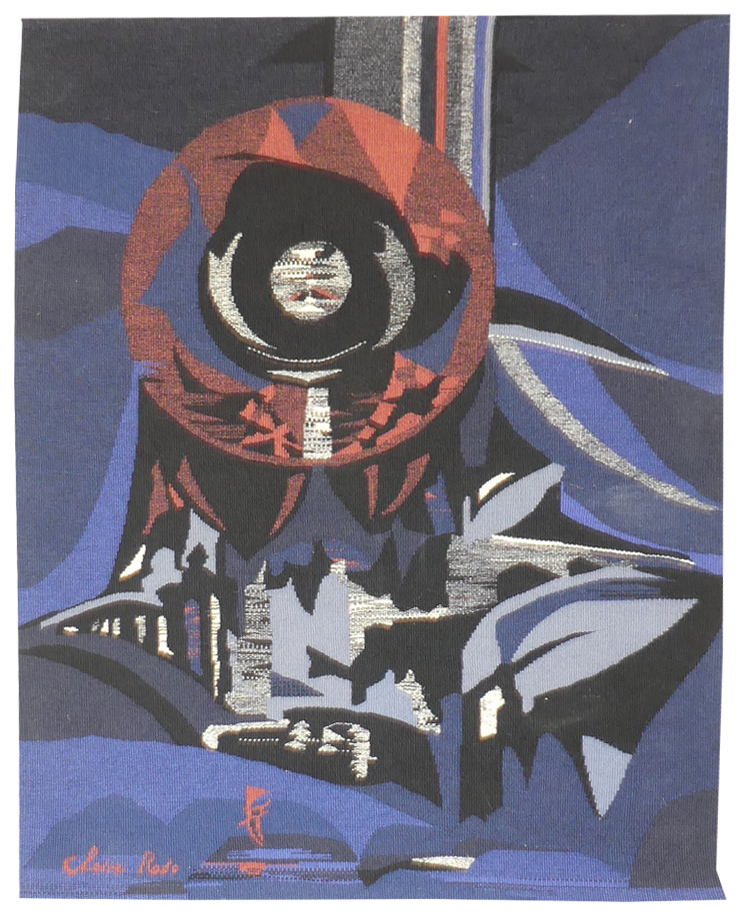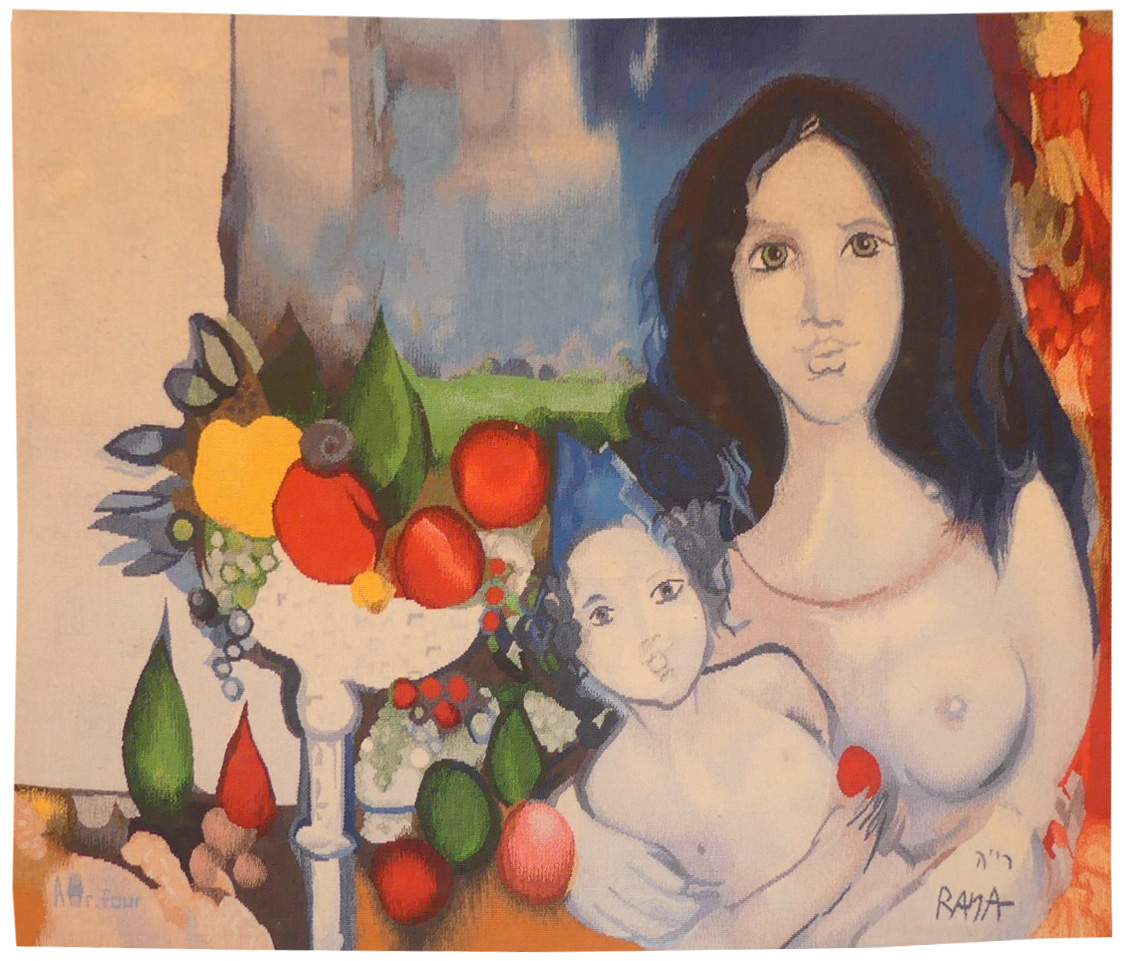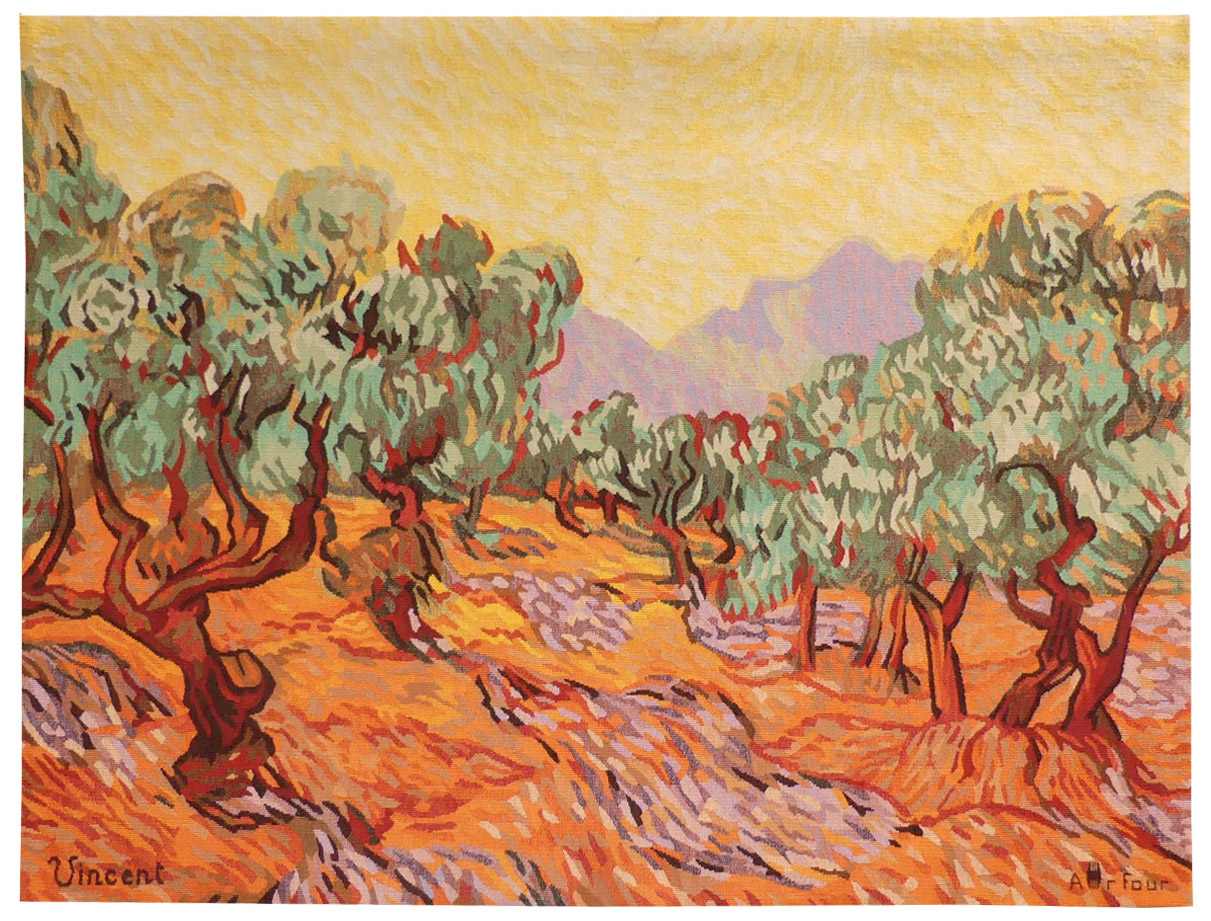-
Essentially known to the artistic community for her ink drawings and illustrations, Filozof is proof of the variety of artists whose work has been woven in Aubusson over the years. Although the naïf style (or one which is at least influenced by folk art) is hardly over-represented (but we can mention here Mady de la Giraudière) : 8 of her designs have been woven by Tabard.Aubusson tapestry woven by the Tabard workshop. With label. Circa 1960.
-
La rivière d'argent (the silver river)
Aubusson tapestry woven in the Hamot workshop to the artist’s cartoon. With certificate of origin signed by the artist. Circa 1960. It was in 1953 that Jean Picart le Doux proposed to Chaye to become his assistant and encouraged him to design tapestry cartoons : he would produce numerous bucolic cartoons, but also views of Normandy (Mont Saint Michel, Honfleur, regattas,…) whence he came. A classic cartoon in the naturalistic vein of this particular artist, who made a speciality of enclosures, hedges and riverbanks with animals. -
les oiseaux (birds)
Aubusson tapestry woven in the Legoueix workshop. n°4/6. Circa 1970. It was in 1953 that Jean Picart le Doux proposed to Chaye to become his assistant and encouraged him to design tapestry cartoons : he would produce numerous bucolic cartoons, but also views of Normandy (Mont Saint Michel, Honfleur, regattas,...) whence he came. Here birds and trelliswork cohabit in a style very reminiscent of Picart le Doux. -
Le rouge et le noir (the red and the black)
Lucas was a protagonist of tapestry renewal in Belgium following on from the “Forces murales” collective. He gave a certain number of cartoons to the Braquenié workshop in Malines in the years 1956 – 1957, designed in a style somewhat reminiscent of Picart le Doux.Aubusson tapestry woven in the Braquenié workshop. With label. Circa 1960. -
Soleil couchant (Sunset)
Fumeron designed his first cartoons (he would ultimately make over 500) in the 1940’s, in collaboration with the Pinton workshop, he was then commissioned on numerous occasions by the state before participating in the decoration of the ocean liner “France”. His work was figurative to begin with and influenced by Lurçat, then turned towards abstraction, before coming back to a style characterised by colourful figurative and realistic depictions from the 1980’s onwards. A recurrent design motif in Fumeron’s work, the setting sun (orange or red) here appears through a screen of trees in a cartoon which verges on abstraction.Aubusson tapestry woven by the Four workshop. n°2/6. Circa 1970. -
Marché aux chameaux (camel market)
In a similar vein to Toffoli, Raymond Poulet criss-crossed the world and his travels provided the themes that inspired his work ; the oriental inspiration has few precursors among the world of the peintre-cartonniers other than Bezombes.Aubusson tapestry produced by Jean Laurent. 1980. -
Epouvantail de lunes (Moon scarecrow)
Aubusson tapestry woven by the Pérathon workshop Complete with certificate of origin signed by the artist, n°1. Circa 1970. Better known for his machine woven panels reminiscent of the work of Picart le Doux, Hurtu also made a few rather more inspired cartoons which were hand woven. -
Courrier Sud (mail heading south)
Aubusson tapestry, woven for Jean Laurent. With label, n°1/6. 1976.Better known for his geometrically inspired paintings incorporating on occasion mechanical elements, Gachon who came originally from Aubusson, did however design a certain number of tapestry cartoons. This particular example is somewhat atypical of his work. -
Bouquet d'automne (autumn bouquet)
A student at the ENAD, Goffinet was a close collaborator of Dirk Holger whose influence (as also that of Prassinos) is notable in the rare tapestries woven from cartoons of his design. On occasion, as in this case, he wove his designs himself.Aubusson tapestry. N°EA1. Circa 1975. -
La vérité cruelle d'un ancien jeu (the crual truth of an old game)
Aubusson tapestry woven in the Pinton workshop. With label. 1970. Best known as an engraver (and, be it said, one of the most important of the XXth century), Pierre Courtin designed several tapestry cartoons (of which one measuring 110m2 (!) is to be seen at the International Labour Organization in Geneva), some of which, like ours, are taken from his engravings.. In this piece, the particular and personal aesthetic of the artist is revealed in the original grouping together of geometrical forms, which can be seen as a little reminiscent of ancient civilisations (pre-columbian particularly). Strange also the choice of colour scheme of this artist, who distances himself from the strong colour contrasts characteristic of his colleagues. -
Chant d'oiseaux (birdsong)
Odette Caly, considered a specialist in floral arrangements, designed numerous cartoons for Aubusson, woven in the Pinton, Henry or Hamot workshops. The plant decor here is enlivened by birds, in a style that Henri Ilhe would not have denied. Bibliography : Caly, Publications filmées d’art et d’histoire, 1972Aubusson tapestry woven in the Pinton workshop. With signed label, n°1/6. Circa 1970. -
Les beaux jours (fine weather)
Aubusson tapestry woven in the Henry workshop. With signed label, n°2/6. Circa 1980. -
Rêve gris (Grey dream)
An unreferenced artist, Monique Brix submitted a few tapestry cartoons to Aubusson which were woven by the Glaudin-Brivet or Pinton workshops.Aubusson tapestry woven by the Glaudin-Brivet workshop. With signed label, n°6/6. Circa 1980. -
Enclos végétal (plant enclosure)
Representing the prolific Belgian school of modern tapestry, Mary Dambiermont, is one of its most sensitive protagonists whose work is resolutely figurative. She made her tapestry début at the age of 24 in 1956 and that led her to a close collaboration with the Braquenié establishment in 1958 and from there to two participations in the Biennales de tapisserie in Lausanne in 1962 and 1965. The world she inhabits is a singular place peopled with hieratic figures, often feminine who inhabit dream-like landscapes which are strange and occasionally troubling. In 1966 she presented an exhibition of 20 tapestries all dealing with the theme of enclosure : although no wall or fence is visible, perhaps the reference is an allusion to the mediaeval “hortus conclusus". Bibliography : Paul Caso, Mary Dambiermont, Editions Arts et voyages, 1975, ill p.110Tapestry woven by the Braquenié workshop. Circa 1965. -
Sarabande
After the traditional completion of some mural paintings in the 1930’s, he then arrived in Aubusson in 1936, became closely associated with Picart le Doux in 1947 and then joined the A.P.C.T. (Association des Peintres-Cartonniers de Tapisserie). From then on he devoted himself to tapestry with zeal and designed 167 cartoons, at first figurative following on from Picart le Doux and Saint-Saëns, then, influenced by the scientific themes that he dealt with, tending more towards abstraction. In 1981, two years before his death, he donated his studio to the Musée départemental de la tapisserie in Aubusson. Already, before « Passacaille » which would be produced in 1955, Jullien here reveals his interest in dance and music, recurrent themes although rarely illustrated in such an explicit way, with the guitar and oboe playing as if by magic. Might it be that the notes of the sheet-music are suggested by the bird outlines pictured along the parchment-phylactery ? Bibliography : Exhibition catalogue Hommage à Louis-Marie Jullien, Aubusson, Musée départemental de la Tapisserie, 1983Aubusson tapestry woven in the Pinton workshop. With label. 1954. -
Coquerelle (Pasque flower)
After the traditional completion of some mural paintings in the 1930’s, he then arrived in Aubusson in 1936, became closely associated with Picart le Doux in 1947 and then joined the A.P.C.T. (Association des Peintres-Cartonniers de Tapisserie). From then on he devoted himself to tapestry with zeal and designed 167 cartoons, at first figurative following on from Picart le Doux and Saint-Saëns, then, influenced by the scientific themes that he dealt with, tending more towards abstraction. In 1981, two years before his death, he donated his studio to the Musée départemental de la tapisserie in Aubusson. Rather than the purple colour, it is the sound of the name of the flower that was the effect desired by Jullien for the title of this piece. It is contemporaneous with another piece titled “Capucine” which was woven to the same dimensions. Bibliography : Exhibition catalogue Hommage à Louis-Marie Jullien, Aubusson, Musée départemental de la Tapisserie, 1983Aubusson tapestry woven in the Legoueix workshop. With label, n°4/6. 1967. -
Au coeur de l'ombre (At the heart of darkness)
After the traditional completion of some mural paintings in the 1930’s, he then arrived in Aubusson in 1936, became closely associated with Picart le Doux in 1947 and then joined the A.P.C.T. (Association des Peintres-Cartonniers de Tapisserie). From then on he devoted himself to tapestry with zeal and designed 167 cartoons, at first figurative following on from Picart le Doux and Saint-Saëns, then, influenced by the scientific themes that he dealt with, tending more towards abstraction. In 1981, two years before his death, he donated his studio to the Musée départemental de la tapisserie in Aubusson. This cartoon (the only one dating from 1971) is a prelude to 1972, the year of the « ombres » “shadows” : every 13th cartoon he designs that year has the word in its title; a possible reference to the contemporaneous design of stained glass windows for the temple (protestant church) in Villefavard. Bibliography : Exhibition catalogue Hommage à Louis-Marie Jullien, Aubusson, Musée départemental de la Tapisserie, 1983, n°148 (the model is illustrated)Aubusson tapestry woven in the Legoueix workshop. With signed label, n°1/3 (and handwritten note "tirage arrêté 1/2" [stopped edition 1/2]). 1971. -
Les vieilles marches (the ancient steps)
Aubusson tapestry woven by the Four workshop. With label, n°EA2/2. Circa 1980. -
Mexicaine aux arums (mexican with arum lilies)
Toffoli produced a large number of tapestries in collaboration with the Robert Four workshop from 1976 onwards, designing several hundred cartoons. In them we find post-cubist transparent effects which are characteristic of the artist, as indeed are the subjects treated. Thus Toffoli’s tapestries do not differ from his painting : travelling for inspiration, here he illustrates scenes observed during his travels in South America.Aubusson tapestry woven by the Four workshop. With label, n°1/6. Circa 1990. -
Waistcoat l'enfant aux mirages (child with mirages)
Aubusson tapestry woven by the Legoueix workshop. 1997.Provenance : Sautour-Gaillard workshopA pupil of Wogensky at the Ecole Nationale Supérieure des Arts Appliqués, Sautour-Gaillard had his first cartoon woven in 1971 by the Legoueix workshop (a collaboration which was to last), and from then on he designed many very large-scale projects of which the most spectacular was “Pour un certain idéal” a series of 17 tapestries dealing with the theme of Olympianism (property of the Musée de l’Olympisme in Lausanne). If at first close to lyrical abstraction, the artist produced in the 1990’s cartoons superimposing different decorative motifs, textures and figures whose unity originated in the woven texture itself. The 2 waistcoats from the exhibition « Archéologies » which was held at the Inard gallery in 1997, are evidence of the wish expressed at the period by people from Aubusson, which was going through difficult times, to widen their activity : Sautour-Gaillard, who was himself an enthusiastic collector of fabrics, reveals here the same inspiration as in his contemporary woven collages. Bibliography : D. Cavelier, Jean-René Sautour-Gaillard, la déchirure, Lelivredart, 2013, ill. p.6, (worn by the artist) 296 -
Matin d'été (summer morning)
Aubusson tapestry woven in the Laurent workshop. With signed label, n°2/6. 1983.A former student at the ENAD in Aubusson, Lartigaud created his first tapestry cartoon in 1968. He went on to design hundreds more, most of them woven by the Four Workshop. Although his cartoons are mainly abstract, there is also a bucolic side to his work, that Fumeron would not have disowned. -
Composition
Aubusson tapestry woven in the Four workshop. N°EA2/2. Circa 1980.A former student at the ENAD in Aubusson, Lartigaud created his first tapestry cartoon in 1968. He went on to design hundreds more, most of them woven by the Four Workshop, in an abstract style occasionally studded with celestial bodies. -
Hautes brandes (High heather)
Aubusson tapestry woven in the Four workshop. With label, n°EA1. Circa 1980.A former student at the ENAD in Aubusson, Lartigaud created his first tapestry cartoon in 1968. He went on to design hundreds more, most of them woven by the Four Workshop : Their decorative vocation often vacillates between abstraction and figuration. -
Composition
Tapestry woven by the artist. With signed label, and preparatory drawing. Circa 1980. -
Ichtyonis
Tapestry woven in the Raymond workshop. Complete with certificate of origin signed by the artist, n°EA1. Circa 1980. Originally an engraver (Prix de Rome, intaglio technique in 1942), Jean-Louis Viard designed his first tapestry cartoons in the mid 1950’s. At first his work was figurative (he was collaborating at the time with Picart Le Doux), but then he evolved along the same lines as many other painter-cartoonists of the period (Matégot, Tourlière or Prassinos,...) towards abstraction. He produced scores of cartoons working up until the 2000’s, in parallel to his work as a painter and engraver, but throughout revealing a particular interest for the use of contrasting materials and textures in the tradition of the “Nouvelle Tapisserie” of which Pierre Daquin was one of the leading lights. The inspiration for his motifs, sometimes metaphysical (“Mémoires” Memories, “Destins” Destinies,…) is wide-reaching, from astronomical infinity « ténèbres solaires » solar darkness) to the microscopic (« Mutation végétale” Plant mutation) : a profuse and varied production, regularly exhibited at his home, in various public and private exhibition spaces and, most significantly, at the Salon Comparaison of which he was the curator for the Tapestry section. Origin : the artist’s workshop -
Tête de coq (a cock's head)
Aubusson tapestry woven in the Braquenié workshop. With label. Circa 1950. -
Crescendo
Best known as an engraver, Davo reproduces in tapestry the result of his research in that medium, based on the oxydation of different metals placed on the copper plate. The resulting effects are here translated by the difference of relief obtained by different weaving techniques.Aubusson tapestry woven by the Legoueix workshop. With label, n°2/6. Circa 1980.This tapestry is reproduced in the publication « Tapisserie d’Aubusson » produced by the Guéret Chamber of Commerce and Industry at the beginning of the 1980’s to illustrate the technical prowess of the Aubusson tapestry workshops. -
Chasse à courre (Riding to hounds)
A contemporary take on a traditional tapestry theme (for example Maximilien’s hunting scenes among others) with an autumnal colour scheme. Commere was one of the numerous figurative artists whose work was featured by the Moulin de Vauboyen and Pierre de Tartas.Tapestry woven in the Moulin de Vauboyen workshop. Circa 1970. -
Saint François parlant aux animaux (St Francis talking to the animals)
Aubusson tapestry woven in the Perathon workshop. Circa 1940. Jean Bazaine, like many of his contemporaries, was a prolific mural artist particularly for large scale edifices. Although he is above all recognised as a designer of stained glass windows and mosaics, he was also making tapestry cartoons as early as the 1930’s. These pieces formed part of the renewal of religious art of which Bazaine would be one of the principal protagonists, particularly after the war. Jean Bazaine, in association with l’abbé Morel (one of those foremost in promoting the introduction of abstract art into churches), was at the head of a painters’ workshop from 1936 to 1937 hence, undoubtedly, the preoccupations which he had already voiced in the domain of religious art. This particular cartoon, figurative in character, (Bazaine would abandon figurative representation during the war period) employing traditional iconography, is thus a modest example of the artist’s first steps in both mural and religious art. -
Le petit vin blanc (a little white wine)
Aubusson tapestry woven by the Picaud workshop. With label. Circa 1960. Jean Picart le Doux is one of the foremost figures in the renaissance of the art of tapestry. His earliest contributions to the field date back to 1943 when he designed cartoons for the passenger ship “la Marseillaise”. A close associate of Lurçat, whose theories he would adopt (limited palette, numbered cartoons...), he was a founding member of the A.P.C.T. (Association des Peintres-cartonniers de Tapisserie), and soon after, a teacher at the Ecole Nationale Supérieure des Arts Décoratifs. The state gave him several commissions most of them at the Aubusson workshop, and some at the Gobelins : the most spectacular of these being for the University of Caen, the Theatre in Le Mans, the passenger ship France or the Prefecture of the Creuse département ... In as much as Picart le Doux’s aesthetic is close to that of Lurçat, so also is his insipiration and his subject matter, although in a register which is more decorative than symbolic, where he brings together heavenly bodies (the sun, the moon, the stars...), the elements, nature (wheat, vines, fish, birds...), man, literary quotation ... In a symetrical composition such as Picart le Doux prefers, he reproduces certain elements of « Rouge et or » Red and gold (Bruzeau n° 125, 1962). “Nuits Saint-Georges” dates from 1961. But it was Lurçat who was noted for creating cartoons devoted to wine-making themes. Bibliography : Marthe Belle-Joufray, Jean Picart le Doux, Publications filmées d’art et d’histoire, 1966 Maurice Bruzeau, Jean Picart le Doux, Murs de soleil, Editions Cercle d’art, 1972 Exhibition Catalogue, Jean Picart le Doux, tapisseries, Musée de Saint-Denis, 1976 Exhibition Catalogue Jean Picart le Doux, Musée de la Poste, 1980 -
La chèvre (the goat)
Aubusson tapestry woven by the Picaud workshop. With signed label, n°1/6. Circa 1980. Jean Picart le Doux is one of the foremost figures in the renaissance of the art of tapestry. His earliest contributions to the field date back to 1943 when he designed cartoons for the passenger ship “la Marseillaise”. A close associate of Lurçat, whose theories he would adopt (limited palette, numbered cartoons...), he was a founding member of the A.P.C.T. (Association des Peintres-cartonniers de Tapisserie), and soon after, a teacher at the Ecole Nationale Supérieure des Arts Décoratifs. The state gave him several commissions most of them at the Aubusson workshop, and some at the Gobelins : the most spectacular of these being for the University of Caen, the Theatre in Le Mans, the passenger ship France or the Prefecture of the Creuse département ... In as much as Picart le Doux’s aesthetic is close to that of Lurçat, so also is his inspiration and his subject matter, although in a register which is more decorative than symbolic, where he brings together heavenly bodies (the sun, the moon, the stars...), the elements, nature (wheat, vines, fish, birds...), man, literary quotation ... ‘The goat’ (which has all the appearance of a lama) is typical of the artist's last small designs, with a single motif that evokes the signs of the Zodiac. Bibliography : Marthe Belle-Joufray, Jean Picart le Doux, Publications filmées d’art et d’histoire, 1966 Maurice Bruzeau, Jean Picart le Doux, Murs de soleil, Editions Cercle d’art, 1972 Exhibition Catalogue, Jean Picart le Doux, tapisseries, Musée de Saint-Denis, 1976 Exhibition Catalogue Jean Picart le Doux, Musée de la Poste, 1980 -
L'oiseau lyre (the lyrebird)
Aubusson tapestry woven by the Pinton workshop. With label signed by the artist, n°3/6. Circa 1960. Jean Picart le Doux is one of the foremost figures in the renaissance of the art of tapestry. His earliest contributions to the field date back to 1943 when he designed cartoons for the passenger ship “la Marseillaise”. A close associate of Lurçat, whose theories he would adopt (limited palette, numbered cartoons...), he was a founding member of the A.P.C.T. (Association des Peintres-cartonniers de Tapisserie), and soon after, a teacher at the Ecole Nationale Supérieure des Arts Décoratifs. The state gave him several commissions most of them at the Aubusson workshop, and some at the Gobelins : the most spectacular of these being for the University of Caen, the Theatre in Le Mans, the passenger ship France or the Prefecture of the Creuse département ... In as much as Picart le Doux’s aesthetic is close to that of Lurçat, so also is his inspiration and his subject matter, although in a register which is more decorative than symbolic, where he brings together heavenly bodies (the sun, the moon, the stars...), the elements, nature (wheat, vines, fish, birds...), man, literary quotation ... This lyrebird motif dates from 1954 and is taken from a larger and richer design incorporating a garden « à la française ». Picart le Doux habitually recycled elements from earlier designs. Bibliography : Marthe Belle-Joufray, Jean Picart le Doux, Publications filmées d’art et d’histoire, 1966 Maurice Bruzeau, Jean Picart le Doux, Murs de soleil, Editions Cercle d’art, 1972 Exhibition Catalogue, Jean Picart le Doux, tapisseries, Musée de Saint-Denis, 1976 Exhibition Catalogue Jean Picart le Doux, Musée de la Poste, 1980 -
L'oiseau d'argent ( the silver bird)
Jane Perathon was chief weaver in her Aubusson workshop (amongst others she wove designs for Lurçat) ; she also (as did other weavers, Hecquet for example) designed several cartoons of her own.Aubusson tapestry woven by Jane Perathon's workshop. With signed label, n°6 Circa 1970. -
Roc neige (rock snow)
Tapestry woven by the L.M. workshop in Calais. With signed label, n°EA1. Circa 1970.A glassmaker (he designed many stained glass windows for public buildings, particularly in the Boulonnais region), engraver, painter and photographer, Lhotellier had many strings to his bow. Typical of his work from around 1970, our tapestry bears witness to the existence of little-known weaving workshops capable of accomplished creations, far from what was being done in Aubusson at the time. -
L'oiseau de rêve (the dream bird)
A local boy, Henri de Jordan met Firmin Bauby in Perpignan, the man behind the San Vicens ceramics workshop. It was there that he discovered painting on ceramics, as well as tapestry, through Lurçat and Picart le Doux. Our cartoon bears witness to this influence: it is the work of a young artist still marked by the tutelary shadow of his elders (Lurçat died that same year).Aubusson tapestry woven in the Tabard workshop. With signed label. 1966. -
Portrait
Aubusson tapestry woven by the Pinton workshop. With label, n°1/6. Circa 1980.Doubtless a tapestry woven from a work by Hélène Champaloux (with an X !), in a style reminiscent of posters of the 1970’s, featuring a face treated as if by solarization : a very rare subject for a tapestry! -
Idylle pastorale (pastoral idyll)
Georges Rougier, who taught drawing at school in Aubusson, produced numerous cartoons for the Aubusson workshops and the Mobilier National, and worked alongside Marius Martin when he was head of ENAD. Along with Maingonnat and Faureau, Martin made him one of the main protagonists of a pictorial aesthetic resolutely turned towards tapestry, which was expressed in particular at the Exposition Internationale des Arts Décoratifs in Paris in 1925 (Rougier also had his own stand there!). Bibliography : Exhibition Catalogue « Tapisseries 1925. Aubusson, Beauvais, les Gobelins à l’Exposition Internationale des Arts Décoratifs de Paris », Aubusson, Cité de la Tapisserie, 2012Aubusson tapestry. Circa 1930. -
Figure de trois (Triplet)
Tapestry woven by the Saint-Cyr workshop. With signed label, n°1/6. Circa 1970. An unknown artist, whose inspiration finds its source in the instruments and theory of Music ; a geometric evocation of a keyboard and the stave serve as a framework for the cartoon. -
Concerto
Tapestry woven by the Saint-Cyr workshop. With signed label, n°1/6. Circa 1970. An unknown artist, whose inspiration finds its source in the instruments and theory of Music ; a geometric evocation of a keyboard and the stave serve as a framework for the cartoon. -
Oiseaux (birds)
Edmond Dubrunfaut can be considered as the great 20th century renovator of the Belgian tapestry tradition. He founded a weavers’ workshop in Tournai as early as 1942, then, in 1947, created the Centre de Rénovation de la Tapisserie de Tournai. He produced for various Belgian workshops (Chaudoir, de Wit,...) numerous cartoons destined notably to adorn Belgian embassies throughout the world. Moreover, Dubrunfaut was a teacher of monumental art forms at the Academie des Beaux-Arts de Mons from 1947 to 1978 and then, in 1979, contributed to the creation of the Fondation de la tapisserie, des arts du tissu et des arts muraux de Tournai, a veritable heritage centre for the art of the tapestry in Wallonie. His style, characterised by figuration, strong colour contrasts, draws direct inspiration from nature and animal life (as with Perrot, for example, this artist has a net predilection for birdlife). A classic subject for Dubrunfaut, woven in Aubusson by Simone André in the 50s and 60s. Bibliography : Exhibition catalogue Dubrunfaut et la renaissance de la tapisserie, tableaux, dessins, peintures, Musée des Beaux-Arts de Mons, 1982-1983.Aubusson tapestry woven by the Simone André workshop. Circa 1950. -
Double amitié (double friendship)
Edmond Dubrunfaut can be considered as the great 20th century renovator of the Belgian tapestry tradition. He founded a weavers’ workshop in Tournai as early as 1942, then, in 1947, created the Centre de Rénovation de la Tapisserie de Tournai. He produced for various Belgian workshops (Chaudoir, de Wit,...) numerous cartoons destined notably to adorn Belgian embassies throughout the world. Moreover, Dubrunfaut was a teacher of monumental art forms at the Academie des Beaux-Arts de Mons from 1947 to 1978 and then, in 1979, contributed to the creation of the Fondation de la tapisserie, des arts du tissu et des arts muraux de Tournai, a veritable heritage centre for the art of the tapestry in Wallonie. His style, characterised by figuration, strong colour contrasts, draws direct inspiration from nature and animal life (as with Perrot, for example, this artist has a net predilection for birdlife). A classic subject, but the title refers to an anthropomorphisation of relations between animals, expressing the artist's social (utopian ?) concerns. Bibliography : Exhibition catalogue Dubrunfaut et la renaissance de la tapisserie, tableaux, dessins, peintures, Musée des Beaux-Arts de Mons, 1982-1983, n°239.Aubusson tapestry woven in the Four workshop. With signed label, n°EA1. 1972. -
Rapace (bird of prey)
Edmond Dubrunfaut peut-être considéré comme le grand rénovateur de la tapisserie belge au XXe siècle. Il fonde un atelier de tissage à Tournai dès 1942, puis crée en 1947 le Centre de Rénovation de la Tapisserie de Tournai . Il fournira pour différents ateliers belges (Chaudoir, de Wit,...) de nombreux cartons destinés notamment à orner les ambassades belges à travers le Monde. Par ailleurs, Dubrunfaut, de 1947 à 1978, enseigne l’art monumental à l’Académie des Beaux-Arts de Mons, puis, en 1979, participe à la création de la Fondation de la tapisserie, des arts du tissu et des arts muraux de Tournai, véritable conservatoire de la tapisserie en Wallonie. Son style, figuratif, usant de forts contrastes de couleurs souvent, est très inspiré par les animaux et la nature (comme Perrot par exemple, l'artiste a un fort tropisme pour l'ornithologie). Tapisserie tardive de Dubrunfaut, à la veine décorative toujours renouvelée, tissée au CRECIT à Tournai, où l’artiste a donné de nombreux cartons à tisser. Bibliography : Exhibition catalogue Dubrunfaut et la renaissance de la tapisserie, tableaux, dessins, peintures, Musée des Beaux-Arts de Mons, 1982-1983.Tapestry woven by the CRECIT workshop, in Tournai. With label. 1995. -
Les 2 écureuils (the 2 squirrels)
Tapestry woven by the de Wit workshop. With signed label. Circa 1960. -
Belle entente (nice relationship)
Edmond Dubrunfaut can be considered as the great 20th century renovator of the Belgian tapestry tradition. He founded a weavers’ workshop in Tournai as early as 1942, then, in 1947, created the Centre de Rénovation de la Tapisserie de Tournai. He produced for various Belgian workshops (Chaudoir, de Wit,...) numerous cartoons destined notably to adorn Belgian embassies throughout the world. Moreover, Dubrunfaut was a teacher of monumental art forms at the Academie des Beaux-Arts de Mons from 1947 to 1978 and then, in 1979, contributed to the creation of the Fondation de la tapisserie, des arts du tissu et des arts muraux de Tournai, a veritable heritage centre for the art of the tapestry in Wallonie. His style, characterised by figuration, strong colour contrasts, draws direct inspiration from nature and animal life (as with Perrot, for example, this artist has a net predilection for birdlife). The title refers to the artist's preoccupation with social harmony: the human figure, omnipresent in his early work, returns to illustrate an irenic theme. Bibliography : Exhibition catalogue Dubrunfaut et la renaissance de la tapisserie, tableaux, dessins, peintures, Musée des Beaux-Arts de Mons, 1982-1983.Tapestry woven in the DMD workshop, Tournai. With label. 1989. -
Soleil pour Maria Pia (Sun for Maria Pia)
Aubusson tapestry woven by the Pinton workshop. With label, n°1/3. Circa 1970. Holger was a student at the Ecole Nationale d’Art Décoratif d’Aubusson and worked with Lurçat before the latter’s death in 1966. He designed numerous dream-like cartoons woven by the Aubusson workshop. Now settled in the United States, he remains a tireless advocate for, and witness to, modern tapestry design, organising exhibitions and lectures on the subject. -
La huppe rouge (the red hoopooe)
Aubusson tapestry woven by the Picaud workshop. With signed label, n°3/6. Circa 1970.Originally from the Limousin region of France (and the daughter of the master glass-blower François Chigot), Delphine Bureau-Chigot devoted a large part of her creative energies (she was also a painter and a pastel artist) to tapestry design (something over a hundred) which were for the most part woven by the Picaud workshop, often evoking a dream-like world where animals (and notably birds) had an important place. -
Joyau (gem)
Tapestry woven by the Braquenié workshop. With label, n°1. Circa 1975.A rare example of this artist’s work for the loom : in it we find his characteristically complicated formal arrangements. -
Composition
Claude Bleynie discovered the art of tapestry with Jean Picart le Doux in 1952. He exhibited at the La Demeure gallery (from 1958) and participated in the main exhibitions devoted to mural art. His tapestry production counts more than 300 cartoons, mainly realised by the Andraud workshop. Bleynie, in a more abstract vein (which can also be found in his tapestries) notably designed cartoons for rugs which were intended for the luxurious appartment christened “Ile de France” on the ocean liner “France”. Bleynie, who also worked as a set designer in the theatre, designed numerous cartoons inspired by Dance and featuring animated masked and winged figures in fairy-like evocations.Aubusson tapestry woven in the Andraud workshop. Circa 1960. -
La nuit (the night)
In 1964 Claire Rado designed and wove in her workshop in Suresnes, her very first tapestry which she then exhibited at the Galerie La Demeure. She weaves her own cartoons, but, rather like Daquin or Coffinet for example, also produces the work of others (Soulages notably as far as Rado is concerned). Her first abstract works were followed by monumental woven figures around which she left the warp bare. A tapestry dating from the artist’s early work, where the subject is chosen and dealt with to contribute to her technical skills.Tapestry woven by Claire Rado's workshop. With signed label. Circa 1965. -
Maternité (Motherhood)
Aubusson tapestry woven by the Four workshop. With signed label, n°5/6. Circa 2000. -
Oliviers avec ciel jaune et soleil (Olive trees with yellow sky and sun)
The Four workshop produced a certain number of hand-woven tapestries which depicted works of the great masters : thus Klee, Modigliani, Macke or, as here, Van Gogh are faithfully reproduced in wool that reflects the shading and brushstrokes of the artist’s original.Aubusson tapestry woven by the Four workshop. With label, n°6/6. After a painting by the artist, produced in 1889, in the Minneapolis Institute of Arts.



